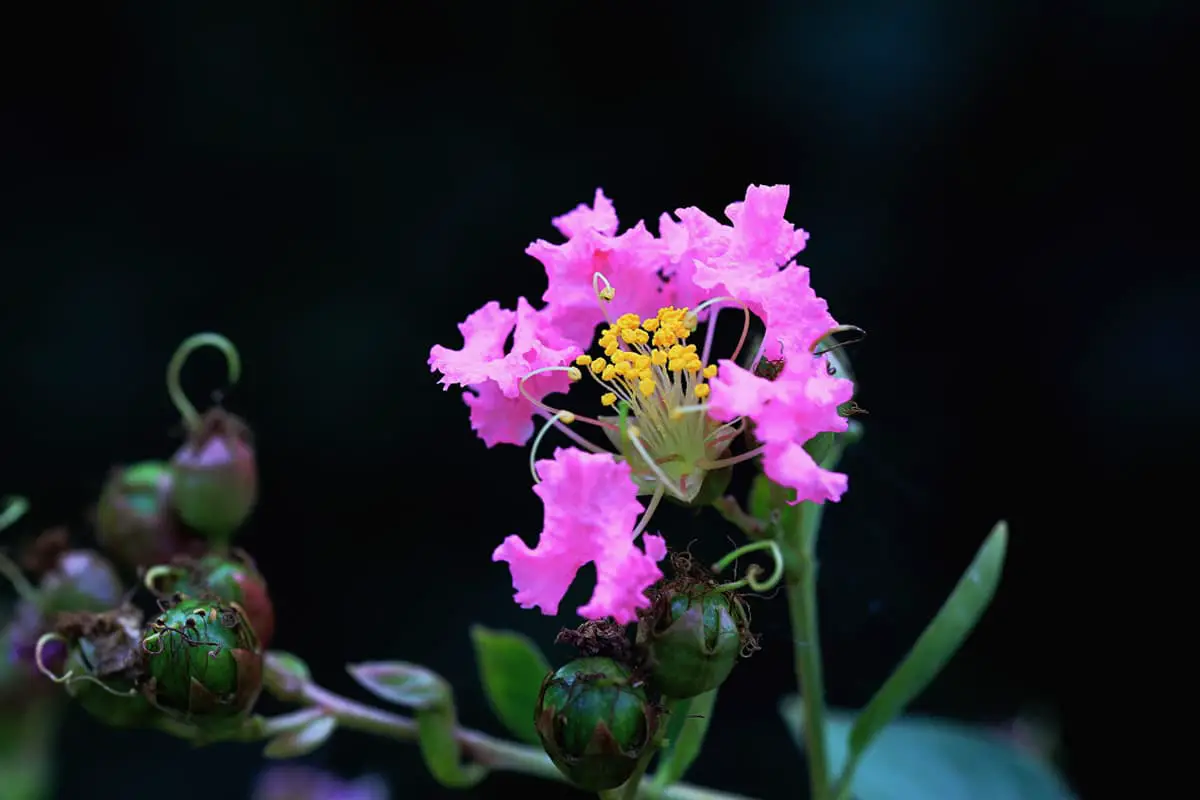
Lagerstroemia indica, commonly known as Crape Myrtle, is a deciduous shrub or small tree belonging to the Lythraceae family. It is characterized by a tall trunk with smooth, exfoliating bark that ranges from light gray to cinnamon-brown, often creating a mottled appearance. The branches typically exhibit a graceful, sinuous form with slender twigs that develop a slightly flattened or winged shape as they mature.
The leaves of Lagerstroemia indica are simple, opposite, and elliptical to oblong in shape, measuring 2-8 cm in length. They are glossy green during the growing season, turning vibrant shades of yellow, orange, or red in autumn before falling. The foliage emerges late in spring, giving the plant a brief deciduous period.
The flowers, which bloom from late spring to early fall (typically June to September), are the plant’s most striking feature. They appear in dense, showy panicles 15-25 cm long at the branch tips. The individual flowers are crinkled and ruffled, resembling crepe paper, which gives rise to the common name. Colors range from white and various shades of pink to deep purple and red, depending on the cultivar.
The fruit is a dehiscent capsule, ellipsoid to subglobose in shape, containing numerous small, winged seeds. Fruiting occurs from September to December, with capsules persisting on the plant through winter, providing winter interest.
Contrary to the provided information, the name “Crape Myrtle” is not related to the North Star or Chinese astrology. Instead, it derives from the crepe-like texture of its flowers and its superficial resemblance to true myrtles (Myrtus). The plant does, however, hold cultural significance in many Asian countries, symbolizing elegance and longevity.
Native to the Indian subcontinent, Southeast Asia, and northern Australia, Crape Myrtles are well-adapted to warm, humid climates. They thrive in full sun, tolerating partial shade but producing fewer flowers in less sunny conditions. These plants are notably drought-tolerant once established, but they perform best with regular, deep watering during dry spells. They prefer well-drained, slightly acidic soils (pH 5.5-6.5) but can adapt to a variety of soil types, including clay, as long as drainage is adequate.
Crape Myrtles are hardy in USDA zones 7-9, with some cultivars showing increased cold tolerance. They can withstand brief periods of cold but may suffer damage in prolonged freezing conditions.
Propagation is typically done through softwood cuttings taken in early summer or by seed. Cuttings root readily and produce plants identical to the parent, while seed propagation may result in genetic variation.
The medicinal properties of Lagerstroemia indica are recognized in traditional medicine systems. The bark and leaves contain tannins and other compounds with astringent and anti-inflammatory properties. They have been used to treat various ailments, including digestive issues and skin conditions. However, it’s important to note that these uses are based on traditional practices and further scientific research is needed to validate their efficacy and safety.
In horticulture, Crape Myrtle is highly valued for its long blooming period, attractive bark, and manageable size. It is widely used in landscape design as a specimen tree, in groupings, or as a flowering hedge. The species also lends itself well to bonsai culture due to its naturally interesting branch structure and responsiveness to pruning.
Proper pruning is crucial for maintaining the plant’s health and encouraging abundant blooming. Light pruning in late winter or early spring helps shape the plant and promote new growth, while avoiding excessive pruning (often referred to as “crape murder”) which can weaken the plant and reduce flowering.
With its combination of beautiful flowers, interesting bark, and adaptability to various growing conditions, Lagerstroemia indica remains a popular and valuable ornamental plant in gardens and urban landscapes across its suitable climate zones.
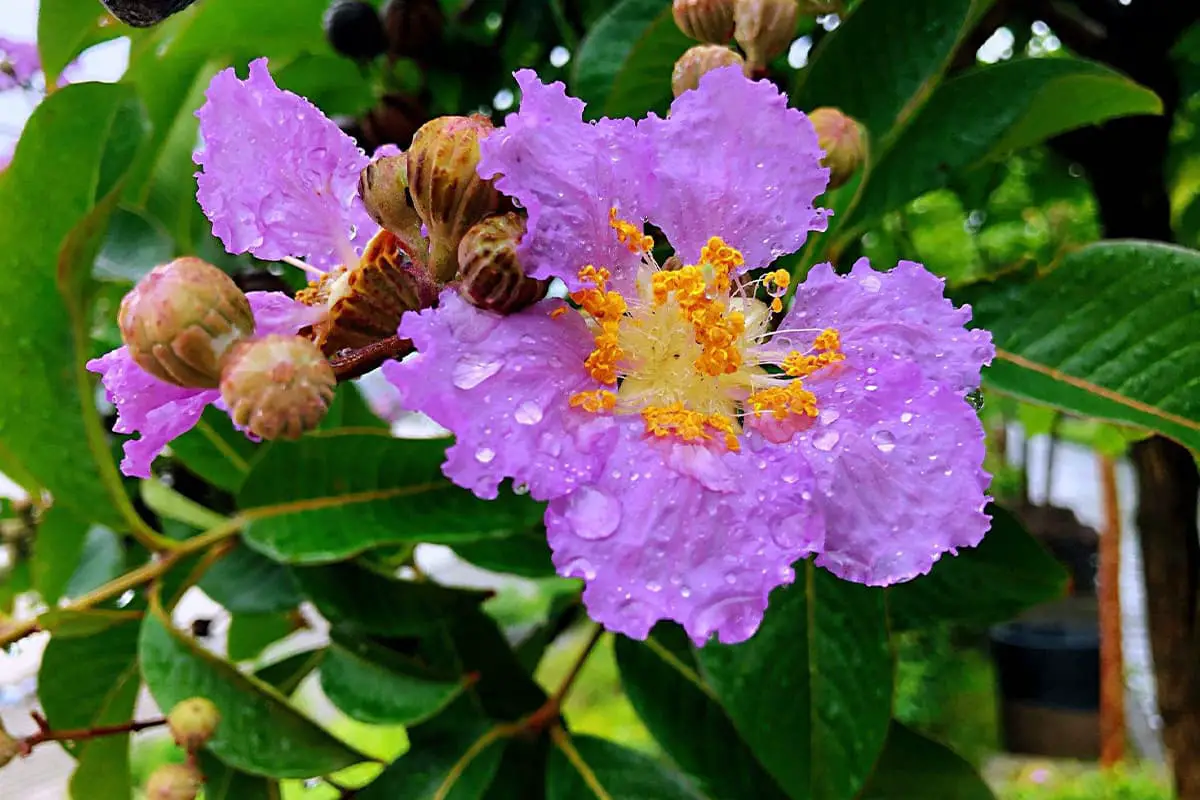
Lagerstroemia speciosa, commonly known as Giant Crape Myrtle or Queen’s Crape Myrtle, is a magnificent tree belonging to the Lythraceae family. This species is characterized by its smooth, exfoliating bark that ranges from pale grey to light brown, and cylindrical twigs that can be glabrous or slightly pubescent.
The leaves of L. speciosa are distinctive, being coriaceous, oblong-elliptic to obovate, and occasionally lanceolate. They exhibit an entire margin with a characteristic curvature and are arranged oppositely or sub-oppositely on the branches. The foliage transitions from bronze-red when young to dark green at maturity, adding to the tree’s ornamental value.
Flowering occurs from late spring to mid-summer, typically May to July, producing large, showy panicles of flowers. The blossoms are striking, ranging from light pink to deep purple, with six nearly orbicular petals that are only slightly crinkled, distinguishing them from other Lagerstroemia species. Each flower measures about 2-3 inches in diameter, creating a spectacular display.
The fruit is a globose to ovoid capsule, approximately 2-3 cm long, which dehisces at maturity to release numerous small, winged seeds. Fruiting typically occurs from October to November, with the capsules persisting on the tree well into winter.
Native to tropical and subtropical regions of Southeast Asia, including Sri Lanka, India, Malaysia, Vietnam, and the Philippines, L. speciosa thrives in full sun and warm, humid climates. It demonstrates remarkable adaptability, tolerating partial shade and exhibiting good resistance to both cold and drought. While it can grow in various soil types, it performs best in deep, well-drained, fertile loams with a slightly acidic to neutral pH.
Propagation of Giant Crape Myrtle can be achieved through seeds, semi-hardwood cuttings taken in summer, or by root suckers. Seed propagation is most common, with fresh seeds germinating readily without pretreatment.
L. speciosa holds significant ethnobotanical importance in its native range. In traditional medicine, various parts of the tree are utilized. The leaves are employed as an astringent in India, while in the Philippines, a decoction of the leaves is widely consumed as a tea for its potential antidiabetic properties. This traditional use has led to its colloquial name “natural plant insulin.” Scientific studies have shown promising results in blood glucose management, though more research is needed to fully understand its efficacy and safety profile.
The potential weight loss benefits associated with L. speciosa tea consumption are likely due to its effects on carbohydrate and lipid metabolism. However, it’s important to note that while traditional use suggests minimal side effects, individuals should consult healthcare professionals before using it medicinally, especially those with existing health conditions or on medications.
In urban landscapes, Giant Crape Myrtle serves multiple functions. Its long-lasting, vibrant flowers make it an excellent ornamental choice for parks, streets, and large gardens. The dense canopy provides significant shade and contributes to air purification by filtering particulates and producing oxygen, thus improving the microclimate of urban areas.
The timber of L. speciosa, often referred to as Jarul or Pyinma wood, is highly prized in the timber industry. Its heartwood is a rich reddish-brown color, extremely durable, and naturally resistant to decay and insect infestation. This makes it valuable for construction, flooring, and high-quality furniture production.
In conclusion, Lagerstroemia speciosa is a versatile species offering ornamental beauty, potential medicinal benefits, and valuable timber. Its adaptability to various growing conditions and its multiple uses make it an important tree in both its native habitats and in cultivation worldwide.
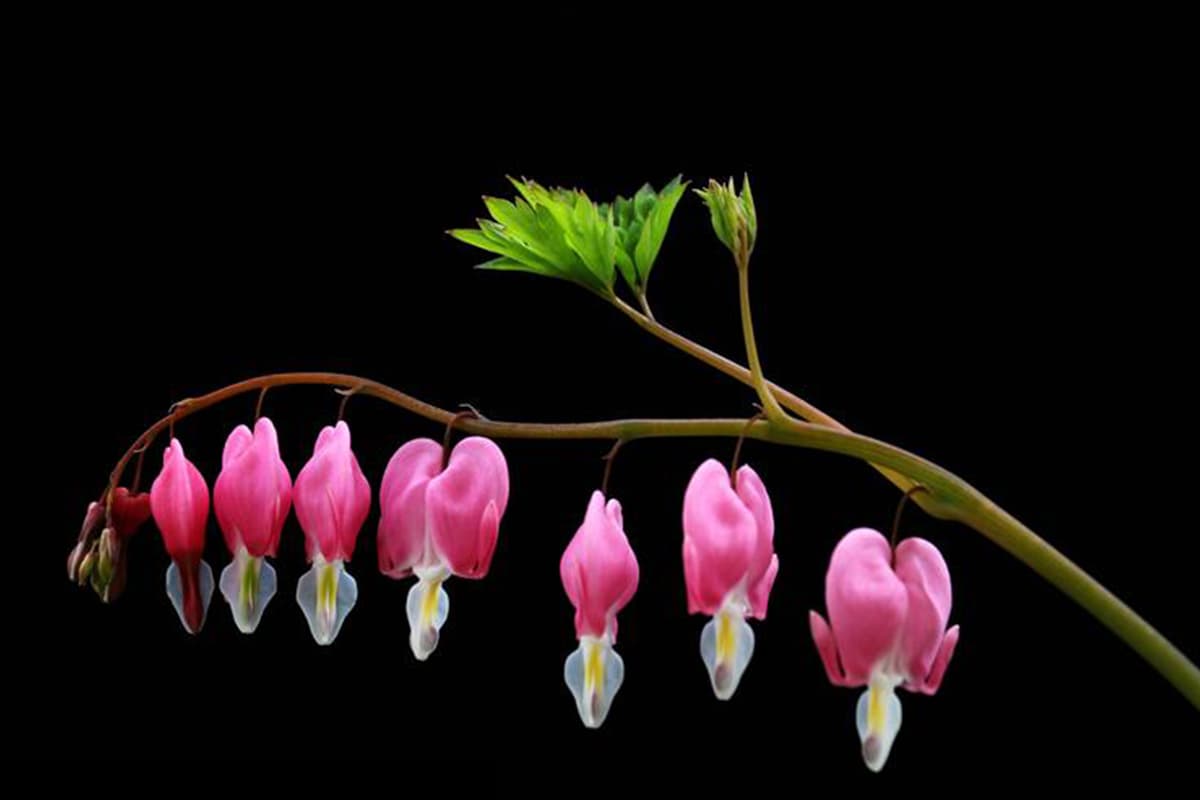
Lamprocapnos spectabilis, commonly known as Bleeding Heart, is a striking perennial herbaceous plant belonging to the Papaveraceae family. This elegant species typically grows to a height of 60 to 120 centimeters (2 to 4 feet) and features a robust system of fleshy rhizomes.
The plant’s stems are upright, smooth, and succulent, forming attractive arching branches. Its foliage is highly ornamental, with compound leaves that are bi- or tri-ternate, featuring deeply lobed leaflets with a blue-green hue. The overall appearance of the foliage is indeed reminiscent of certain peony species.
The inflorescence of Lamprocapnos spectabilis is truly spectacular, consisting of arching racemes that bear numerous heart-shaped flowers. These distinctive blooms dangle gracefully from the stem, resembling delicate lockets or traditional Chinese purses.
The outer petals are typically rose-pink, while the inner petals are white, creating a captivating two-toned effect. While pink is the most common color, cultivars can produce flowers ranging from deep red to pure white. The flowering period generally extends from late spring to early summer, typically April to June in most temperate regions.
Native to the woodlands and stream banks of northern China, Korea, and Siberia, Bleeding Heart has adapted to thrive in partially shaded, cool, and moist environments. It prefers rich, humus-laden soil that retains moisture while still allowing for adequate drainage. While the plant is cold-hardy (USDA zones 3-9), it tends to go dormant during hot summer periods, especially in warmer climates.
Propagation of Lamprocapnos spectabilis can be achieved through various methods. Division of the rhizomes in early spring or fall is the most common and reliable method. Root cuttings taken in late winter can also be successful. While seed propagation is possible, it requires stratification and can be slower than vegetative methods.
In traditional Chinese medicine, Lamprocapnos spectabilis (known as “Yu Jin Cao”) has been utilized for its various therapeutic properties. The entire plant, including roots, stems, and leaves, contains alkaloids and other compounds that contribute to its medicinal effects.
It is considered to have a warm nature and a spicy-bitter taste. Its applications include alleviating pain, reducing spasms, promoting diuresis, regulating menstruation, improving blood circulation, and reducing inflammation. However, it’s crucial to note that the plant contains toxic compounds and should only be used under professional guidance.
Beyond its medicinal uses, Bleeding Heart holds significant cultural and symbolic value. In the language of flowers, it represents romantic love, compassion, and deep emotional attachment. Its unique heart-shaped blooms have made it a popular choice in ornamental gardens, particularly in woodland or shade garden settings.
As a garden plant, Lamprocapnos spectabilis is prized for its elegant form, beautiful foliage, and enchanting flowers. It pairs well with other shade-loving perennials such as hostas, ferns, and astilbes. With proper care, including regular moisture and protection from harsh afternoon sun, Bleeding Heart can be a long-lived and cherished addition to any garden, bringing both beauty and historical significance to the landscape.
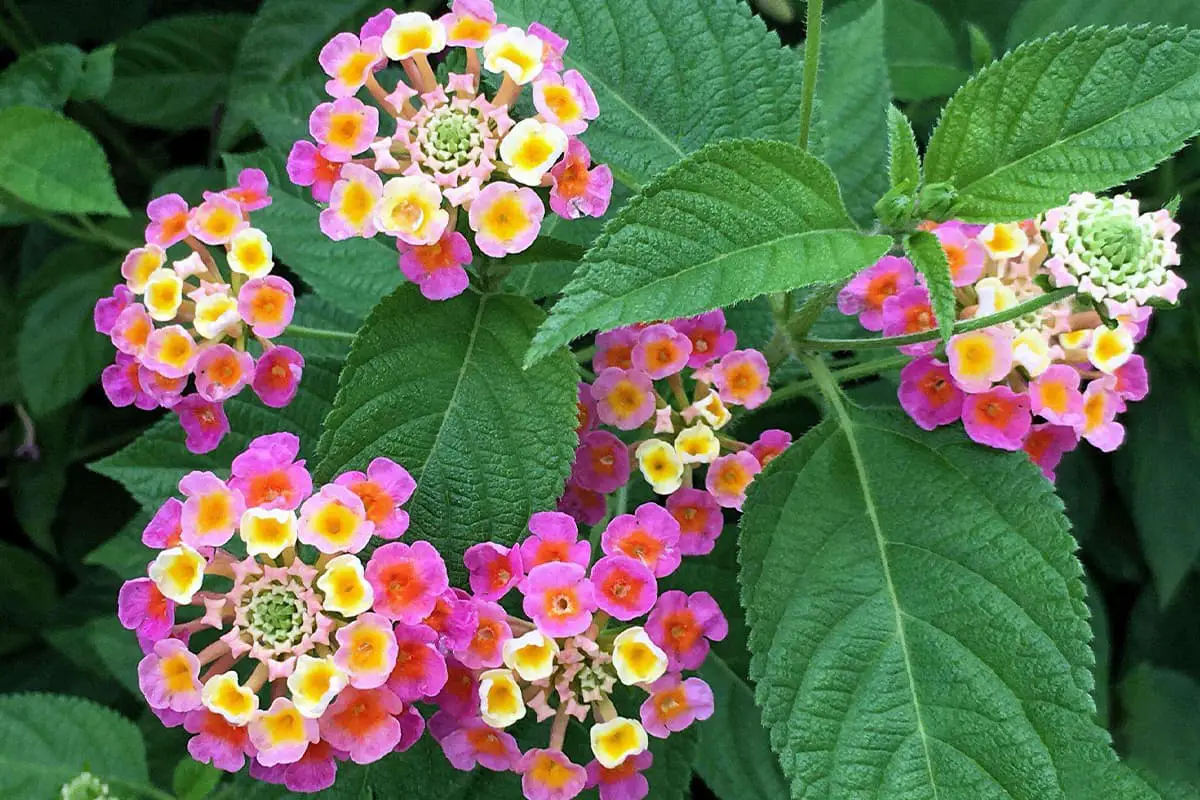
Lantana camara, commonly known as Lantana or Wild Sage, is a robust flowering shrub belonging to the Verbenaceae family. This species is characterized by its distinctive aromatic foliage and its tendency to adopt a sprawling, sometimes vine-like growth habit. The stems and branches are notably quadrangular in cross-section, covered with coarse hairs, and may bear small, recurved prickles or be completely smooth.
The leaves of Lantana camara are arranged in opposite pairs along the stems. They typically have ovate to oblong-ovate blades with serrated margins and a rough, sandpapery texture. The leaf surface is often wrinkled and prominently veined, contributing to the plant’s overall ornamental appeal.
The inflorescences are compact, umbel-like clusters borne on sturdy peduncles that usually exceed the length of the petioles. These flower heads, measuring 2-3 cm in diameter, are composed of numerous small, tubular flowers.
One of Lantana’s most striking features is its polychromatic blooms, which can display a spectrum of colors including yellow, orange, pink, and deep red, often with multiple hues present within a single cluster. This color variation has led to the plant’s comparison with horse tassels, contributing to its common name in some cultures.
Individual flowers are hermaphroditic, with a tubular corolla covered in fine trichomes on both the inner and outer surfaces. As the flowers age, their colors often change, creating a multicolored effect within each inflorescence. This color transformation also serves as a visual cue for pollinators, indicating which flowers are ready for pollination.
The fruit of Lantana camara is a small, fleshy drupe that ripens from green to a glossy purplish-black. Each fruit contains one or two seeds. The spherical shape of these fruits has been likened to ancient medicinal pills, which has influenced its nomenclature in some regions.
Native to the tropical and subtropical regions of the Americas, Lantana camara has now naturalized in many parts of the world, thriving in diverse habitats from sea level up to elevations of 1500 meters. It shows a preference for well-drained soils and full sun exposure, often colonizing disturbed areas, coastal zones, and forest edges.
Lantana exhibits remarkable adaptability to various environmental conditions. It demonstrates high tolerance to drought, heat, and poor soil conditions, making it a resilient plant in challenging landscapes. However, its cold hardiness is limited, with most varieties being suited to USDA zones 8-11.
Propagation of Lantana camara can be achieved through both sexual and asexual methods. While seed propagation is common in its naturalized spread, vegetative propagation through stem cuttings is the preferred method in horticultural settings, ensuring genetic consistency and faster establishment.
Beyond its ornamental value, Lantana camara has several practical applications. Its flowers and leaves contain pigments that can be extracted for use as natural dyes. Additionally, the plant produces volatile organic compounds that have been found to repel or deter various insect species, making it a potential source for botanical insecticides and repellents.
In landscape design, Lantana camara is prized for its long blooming period, which can extend year-round in frost-free climates, and its vibrant flower colors. It is commonly used in street plantings, as a groundcover, in hanging baskets, or as a container plant. Its drought tolerance makes it particularly suitable for xeriscaping and low-maintenance gardens.
However, it is crucial to note that Lantana camara is classified as one of the world’s most invasive weed species in many regions. Its rapid growth and prolific seed production can lead to it outcompeting native flora. Moreover, all parts of the plant, particularly the green berries, contain toxic compounds including lantadene A and B.
These triterpene acids can cause severe hepatotoxicity and photosensitization in livestock, especially cattle and sheep, if ingested in significant quantities. Human toxicity is rare but possible, particularly in children who might be attracted to the colorful berries.
In conclusion, while Lantana camara offers significant ornamental and potential practical benefits, its use should be carefully managed. Gardeners and landscapers should be aware of both its invasive potential and its toxicity, taking appropriate precautions in its cultivation and placement.
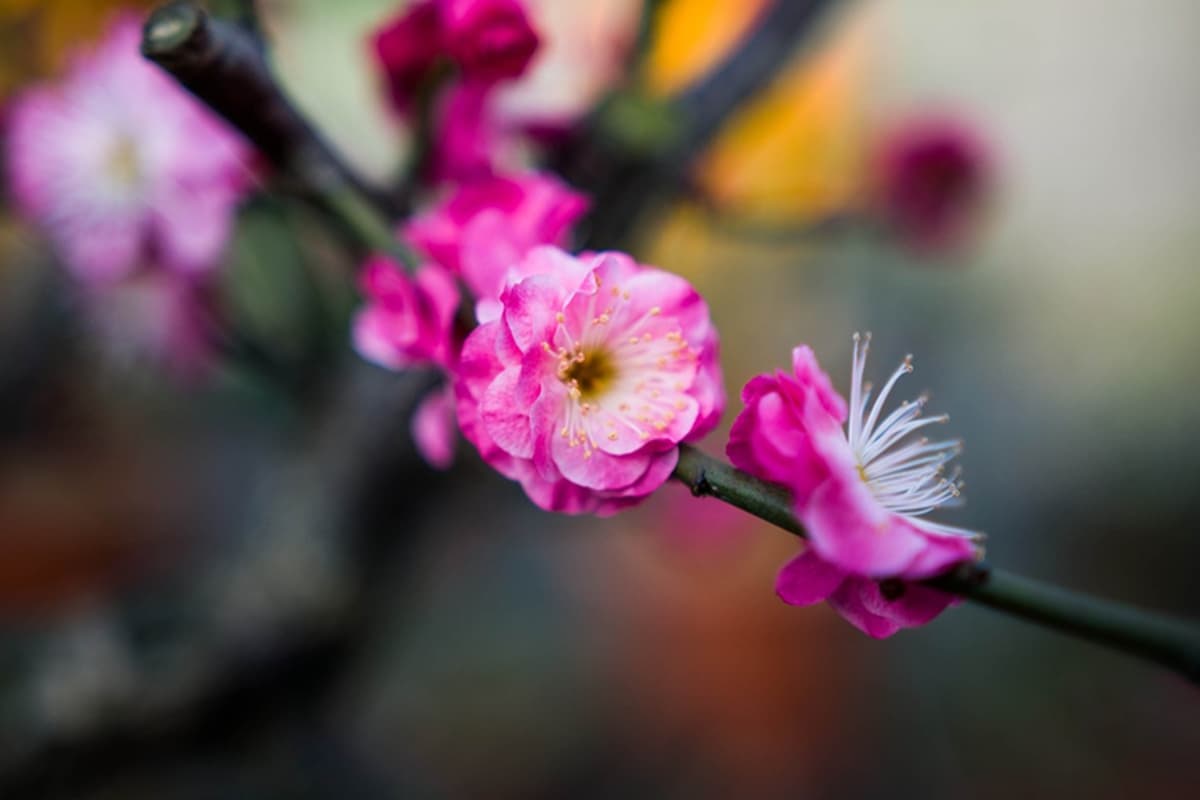
“Late Water At The Corner” is an exquisite variety of plum blossom (Prunus mume) belonging to the Rosaceae family. It is classified within the genuine plum series of the plum blossom lineage, specifically under the var. mume type, and is renowned for its palace-pink coloration.
This exceptional cultivar typically flowers from late February to early March, showcasing a remarkable tendency for double-petaled blooms. Each individual flower can boast up to 45 petals, creating a lush, full appearance. The blossoms emit a subtle yet refined fragrance, contributing to its status as a highly prized and rare variety among plum blossom enthusiasts.
“Late Water At The Corner” was first identified in 1993 by the esteemed Academician Chen Junyu on Plum Blossom Hill in Nanjing, China. This discovery marked a significant contribution to the world of ornamental horticulture and Chinese botanical heritage.
The importance of this cultivar extends beyond its aesthetic appeal. In 1998, the International Society for Horticultural Science (ISHS) appointed Academician Chen as the authoritative registrar for plum varieties. This appointment was groundbreaking, as it represented the first time a Chinese expert was granted international authority in plant variety registration.
Moreover, this event facilitated the official introduction of the term “Mei” (梅, the Chinese word for plum) to the international horticultural community using its Pinyin transliteration. “Late Water At The Corner” holds the distinction of being the first variety registered by Academician Chen under this new system, further cementing its place in horticultural history.
The cultivation of “Late Water At The Corner” requires specific care to ensure optimal growth and flowering. It thrives in well-drained, slightly acidic soil and prefers full sun to partial shade. Regular pruning after flowering helps maintain its shape and encourages robust blooming in subsequent seasons. Like other Prunus mume varieties, it demonstrates good cold hardiness but may benefit from protection against late spring frosts to preserve its delicate blossoms.
This cultivar not only exemplifies the beauty and diversity of plum blossoms but also symbolizes the growing recognition of Chinese contributions to global horticulture. Its unique characteristics and historical significance make “Late Water At The Corner” a valuable addition to both ornamental gardens and botanical collections worldwide.
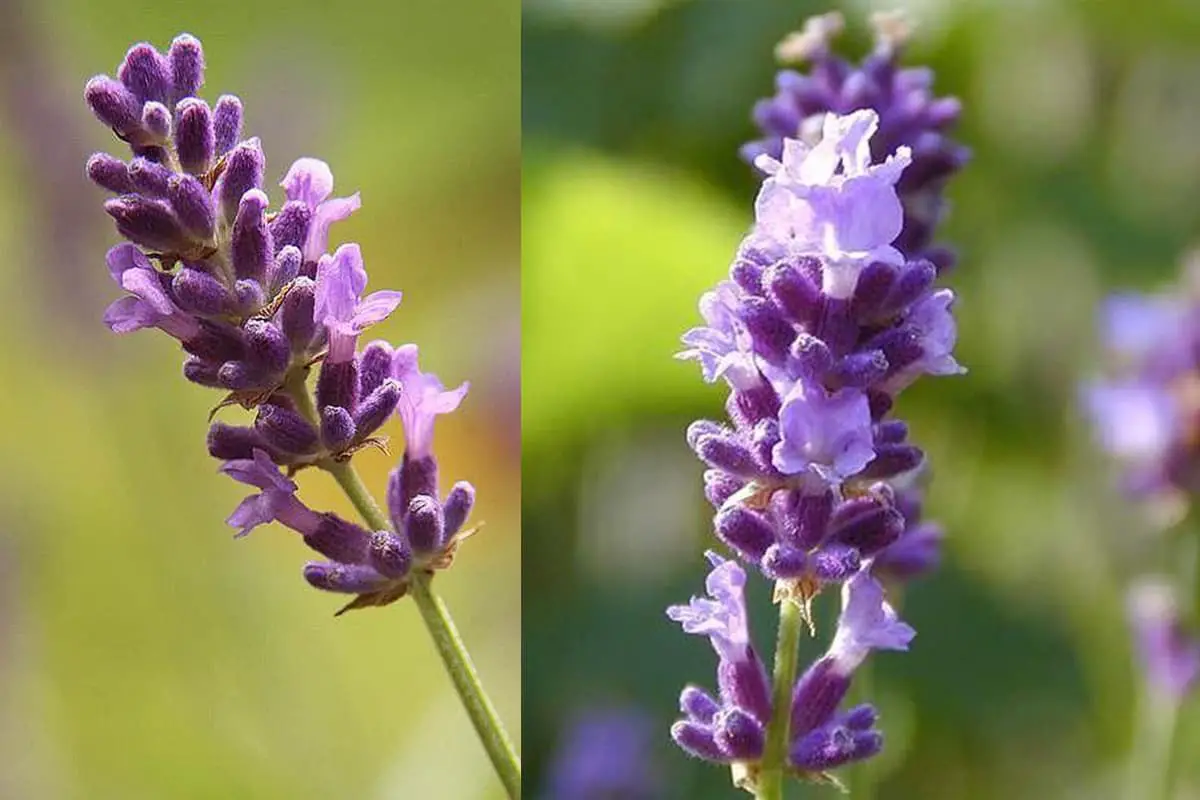
Lavandula angustifolia, commonly known as English Lavender or True Lavender, is a versatile and aromatic perennial shrub belonging to the Lamiaceae family. This compact, woody-based plant typically grows to a height of 60-90 cm (2-3 feet) and forms a mounded shape with upright flower spikes.
The plant’s structure consists of multiple branching stems covered in fine, silvery-gray stellate tomentum, giving it a distinctive appearance. The leaves are linear to linear-lanceolate, measuring 2-6 cm (0.8-2.4 inches) long and 4-6 mm (0.16-0.24 inches) wide.
Foliage on flowering stems is more widely spaced and slightly larger, while leaves on new growth are smaller and densely clustered. Each leaf gradually tapers to a very short petiole at the base. The leaf margins are entire and characteristically revolute (rolled under), with a prominent midrib on the underside.
Lavender’s inflorescence is a verticillaster, forming interrupted or nearly continuous spike-like arrangements at the branch tips. These elegant flower spikes typically measure 5-10 cm (2-4 inches) in length. The individual flowers are small, typically 10-12 mm (0.4-0.5 inches) long, and display a vibrant blue to purple hue. Both flowers and calyces are covered in grayish, branched or unbranched tomentum, contributing to the plant’s overall silvery appearance.
The calyx is ovate-tubular or nearly tubular, 4-5 mm (0.16-0.2 inches) long, with 13 veins and 5 teeth. The bilabiate corolla is approximately twice the length of the calyx, with the upper lip having two lobes and the lower lip having three. Lavender typically blooms from late spring to mid-summer (June to August in the Northern Hemisphere), producing a sweet, woody, and slightly camphoraceous aroma that intensifies in warm weather.
Native to the Mediterranean region, particularly the mountainous areas of southern Europe and northern Africa, Lavandula angustifolia has been widely cultivated across temperate regions globally. It thrives in full sun and well-drained, slightly alkaline soils. The plant demonstrates excellent drought tolerance once established and is hardy in USDA zones 5-9.
Lavender’s popularity in horticulture stems from its attractive foliage, beautiful flower spikes, and intoxicating fragrance. It serves multiple purposes in garden design:
Beyond its ornamental value, Lavandula angustifolia has significant applications in aromatherapy, perfumery, and herbal medicine. The essential oil extracted from its flowers is prized for its calming and antiseptic properties. In culinary use, lavender flowers can add a unique flavor to desserts, herbal teas, and savory dishes when used judiciously.
For optimal growth and abundant flowering, plant Lavandula angustifolia in a sunny location with excellent air circulation. Regular pruning after flowering helps maintain the plant’s shape and promotes longevity. With proper care, this versatile and beautiful herb can be a long-lasting addition to any garden, providing visual interest, fragrance, and ecological benefits for years to come.
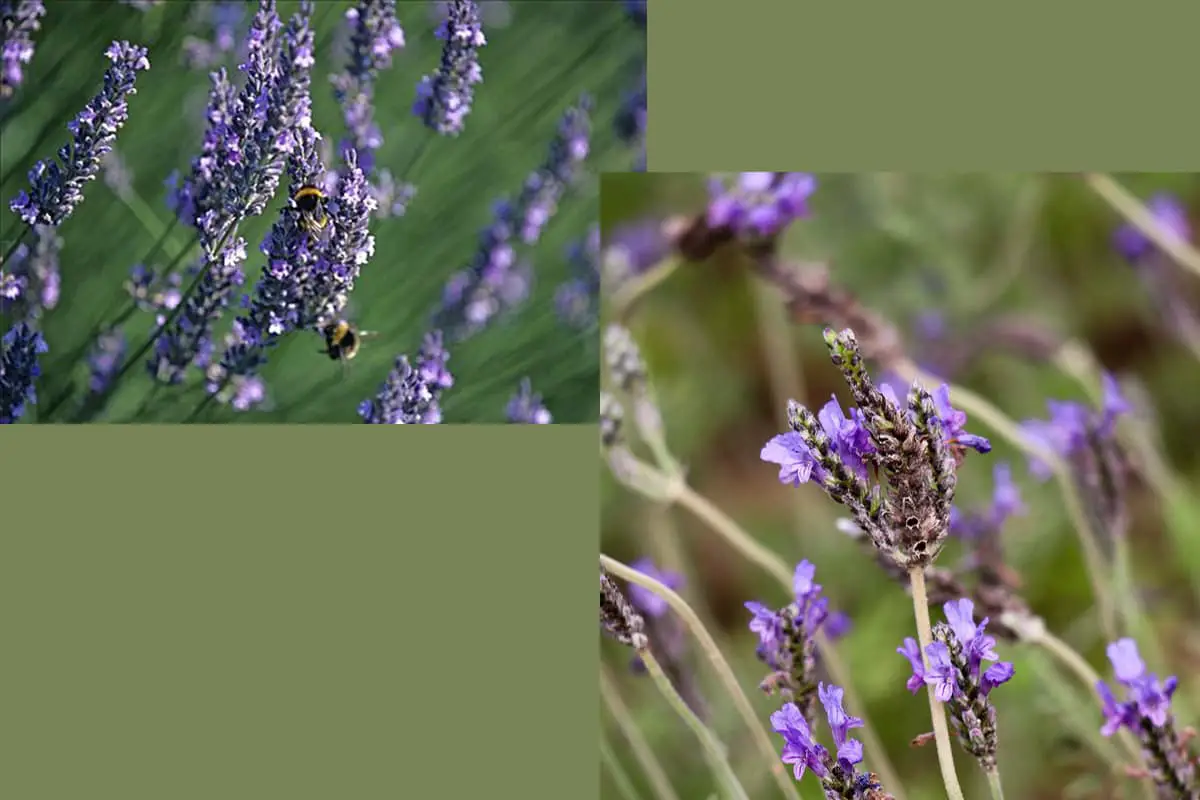
Lavandula angustifolia, commonly known as Narrow-leaf Lavender or English Lavender, is a versatile and aromatic perennial shrub belonging to the Lamiaceae (mint) family. This compact plant typically grows to a height of 30-60 cm (1-2 feet) and spreads 60-90 cm (2-3 feet) wide, forming a bushy, multi-branched structure.
The plant’s most distinctive feature is its narrow, linear leaves, which are 2-5 cm long and only 2-4 mm wide. These leaves are grayish-green in color, with a soft, velvety texture due to the presence of fine hairs. The foliage emits a strong, pleasant fragrance when brushed or crushed.
Flowering occurs from late spring to mid-summer (June to August), producing elegant, spike-like inflorescences. Each spike is composed of small, tubular flowers arranged in whorls. The flowers are typically lavender-blue in color, though cultivars may range from deep purple to pale pink or white. These fragrant blooms are highly attractive to bees and butterflies, making the plant an excellent choice for pollinator gardens.
Native to the Mediterranean region, Lavandula angustifolia thrives in full sun and well-drained, slightly alkaline soils. It demonstrates remarkable adaptability, tolerating both heat and cold (USDA zones 5-9), and showing resistance to drought once established. However, it is sensitive to excessive moisture and humidity, which can lead to root rot and fungal diseases.
Propagation of Narrow-leaf Lavender can be achieved through several methods:
The essential oil extracted from Lavandula angustifolia is highly prized for its therapeutic properties. It contains over 100 compounds, with linalool and linalyl acetate being the primary active ingredients. This oil is renowned for its:
In aromatherapy, the oil is used to promote relaxation, improve sleep quality, and enhance mood. It can be applied topically (when properly diluted), used in diffusers, or added to bath water.
Beyond its medicinal applications, Narrow-leaf Lavender has culinary uses. Its flowers and leaves can be used to flavor teas, baked goods, and savory dishes. In horticulture, it’s valued for its drought tolerance, making it an excellent choice for xeriscaping and low-maintenance gardens.
Regular pruning after flowering helps maintain the plant’s shape and promotes vigorous growth. With proper care, Lavandula angustifolia can thrive for 10-15 years, providing lasting beauty and fragrance to gardens and landscapes.
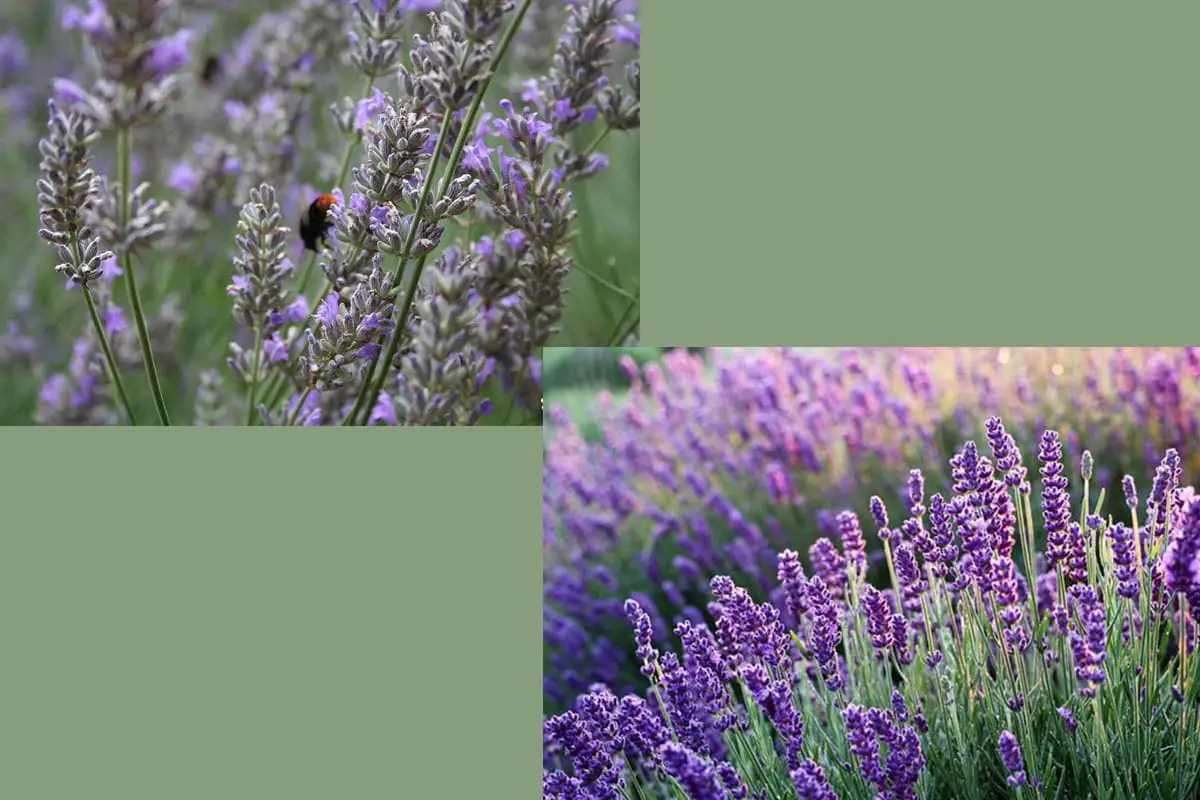
Sidcot Lavender, scientifically known as “Lavandula x intermedia ‘Sidcot’,” is a versatile and aromatic evergreen shrub. This cultivar is a hybrid between English lavender (Lavandula angustifolia) and spike lavender (Lavandula latifolia), combining the best qualities of both parent species.
The plant is characterized by its upright growth habit and long, slender flower spikes that rise well above the foliage. The leaves are narrow, linear, and silvery-green, contributing to the plant’s overall attractive appearance even when not in bloom. The flowers are a soft lavender-blue color, highly fragrant, and appear in mid to late summer.
Sidcot Lavender is widely cultivated for both ornamental and commercial purposes. It thrives in full sun and well-drained, alkaline soils. This cultivar is particularly prized for its cold hardiness and ability to withstand cooler temperatures better than many other lavender varieties.
For optimal growth, the planting bed should be amended with limestone to ensure proper pH levels (6.5-8.0). The soil should be loose, well-draining, and on the drier side to prevent root rot. Sidcot Lavender is drought-tolerant once established and prefers low to moderate humidity.
The flowers and leaves of Sidcot Lavender are rich in essential oils, making it valuable for aromatherapy and the perfume industry. The essential oil is extracted through steam distillation and is known for its calming and antiseptic properties.
In culinary applications, the flowers can be used to enhance the flavor of jams, pastries, and herbal teas. When used in food, lavender imparts a subtle floral note and can add a unique twist to both sweet and savory dishes. It’s important to use culinary-grade lavender and in moderation, as the flavor can be overpowering if used excessively.
Medicinally, Sidcot Lavender is renowned for its stress-relieving properties. It may help ease headaches, promote relaxation, and improve sleep quality. The plant’s natural compounds have mild sedative effects, making it a popular choice for aromatherapy and herbal remedies.
In skincare, Sidcot Lavender’s astringent and anti-inflammatory properties make it beneficial for various applications. It can be used in bath products, lotions, and toners to soothe and cleanse the skin. The essential oil, when properly diluted, may help with minor skin irritations and promote a healthy complexion.
Sidcot Lavender also serves as an excellent pollinator plant, attracting bees and butterflies to the garden. Its drought tolerance and deer resistance make it a low-maintenance choice for landscaping in suitable climates.
When cultivating Sidcot Lavender, it’s essential to provide good air circulation and avoid overwatering. Pruning after flowering helps maintain the plant’s shape and encourages bushier growth. With proper care, this lavender cultivar can be a long-lived and rewarding addition to gardens, offering beauty, fragrance, and a myriad of practical uses.
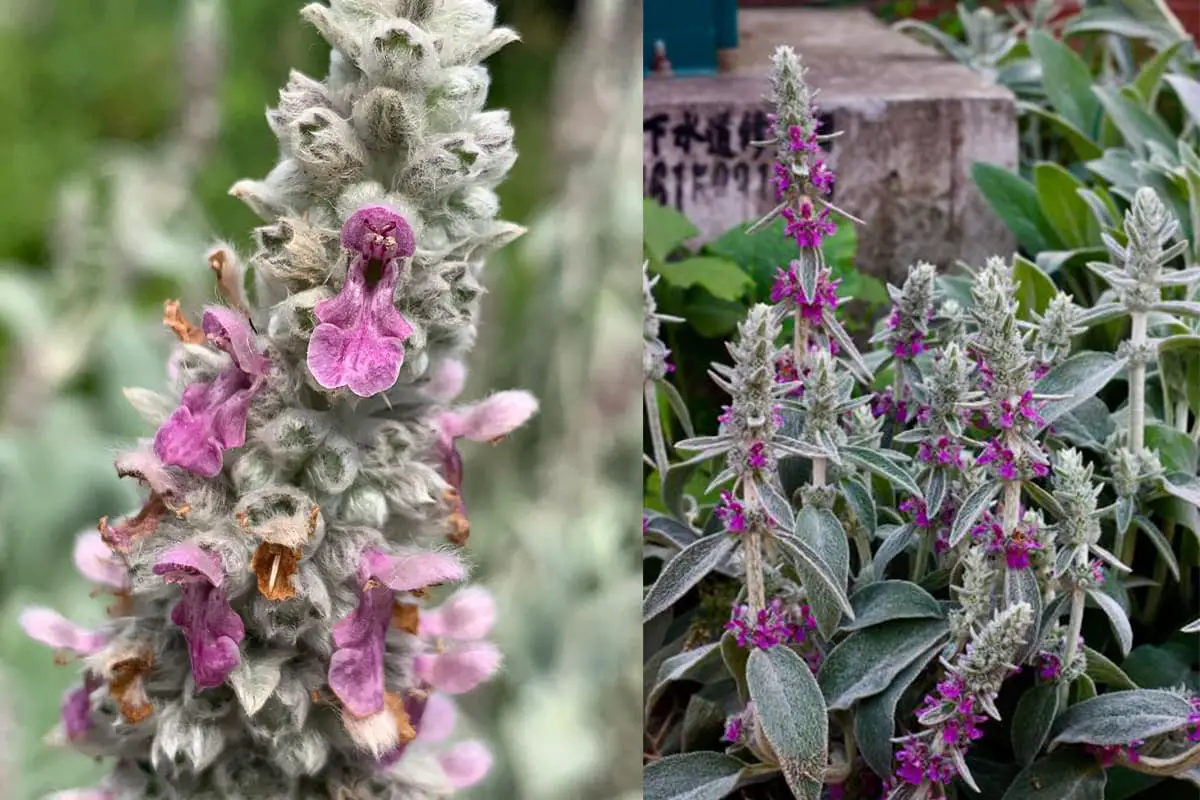
Lavandula lanata, commonly known as Woolly Lavender, is a distinctive member of the Lamiaceae (mint) family. This semi-hardy aromatic subshrub is characterized by its striking silvery-white foliage densely covered in fine, soft hairs, which give it a woolly appearance, and its vibrant purple flowers.
Native to the mountainous regions of southern Spain, particularly the Sierra Nevada and Sierra de Gádor ranges, Lavandula lanata thrives in high-altitude environments, typically between 1,000 to 2,000 meters above sea level. This unique habitat contributes to its specific adaptations and growth requirements.
The plant’s most notable feature is its foliage. The leaves are linear to lanceolate, measuring about 2-4 cm long and 0.5 cm wide. They are densely covered with white, branched trichomes, giving the plant its characteristic woolly texture and appearance. This adaptation helps protect the plant from intense sunlight and reduces water loss in its native arid environment.
In late spring to early summer, Lavandula lanata produces slender flower spikes, typically 3-6 cm long. These spikes bear numerous small, deep purple flowers, creating a beautiful contrast against the silvery-white foliage. The inflorescence is often branched, enhancing its ornamental value.
Despite its mountain origins, Lavandula lanata can be challenging to cultivate in areas with humid winter climates. Its woolly leaves, while an excellent adaptation for its native habitat, tend to absorb and retain moisture in wetter conditions. This moisture retention can lead to fungal issues and potential winter damage in climates with high humidity and wet winters.
For successful cultivation, Lavandula lanata requires well-drained, alkaline soil and full sun exposure. It is particularly suited to rock gardens, gravel gardens, or raised beds that can provide the excellent drainage it needs. In appropriate conditions, it can reach a height of 30-60 cm and spread to about 40-50 cm wide.
In autumn, the plant takes on an even more striking appearance. The dry leaves become almost white under sunlight, creating a luminous effect in the garden. This silvery foliage serves as a perfect backdrop for the deep purple flower spikes, which may produce a second flush of blooms in favorable conditions.
Lavandula lanata is not only prized for its ornamental value but also for its aromatic properties. The leaves and flowers contain essential oils, although the scent is generally milder and less camphoraceous than common lavender (Lavandula angustifolia). These oils have potential applications in aromatherapy and natural cosmetics.
While less common in cultivation than other lavender species, Lavandula lanata is a valuable plant for Mediterranean-style gardens, xeriscaping, and for gardeners looking to add unique texture and color to their landscapes. Its striking appearance and drought tolerance make it an excellent choice for low-water gardens in suitable climates.
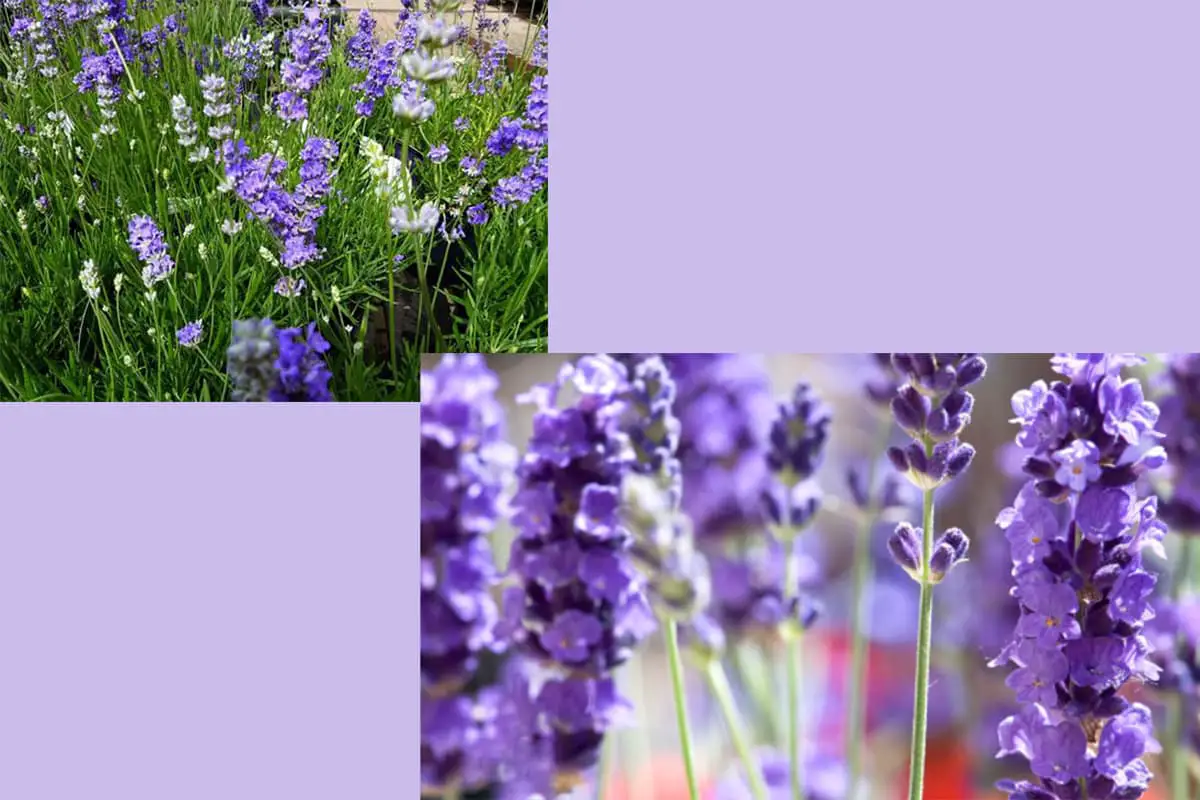
Lavandula angustifolia ‘Munstead’, commonly known as Munstead Lavender, is a compact evergreen subshrub prized for its early flowering habit and versatility in garden design. Developed by the renowned British horticulturist Gertrude Jekyll in the early 20th century, it has become one of the most popular lavender cultivars worldwide.
This cultivar typically reaches a height of 30-45 cm (12-18 inches) with a similar spread, forming a neat, mounded habit. The foliage consists of narrow, linear leaves that are silvery-green in color, providing an attractive contrast to the flower spikes. The aromatic leaves release their distinctive lavender scent when brushed or crushed.
Munstead Lavender produces abundant spikes of fragrant, deep lavender-blue flowers that rise above the foliage. The flowering period usually begins in late spring (May) and can extend through summer (June-August), with the possibility of a second flush in early autumn if properly deadheaded. This extended blooming period contributes to its popularity among gardeners and pollinators alike.
Well-suited for both container cultivation and garden borders, Lavandula angustifolia ‘Munstead’ thrives in full sun and well-drained, slightly alkaline soil. It demonstrates good drought tolerance once established, making it an excellent choice for water-wise gardens. Its compact size makes it ideal for edging paths, creating low hedges, or as a focal point in rock gardens.
In addition to its ornamental value, Munstead Lavender is widely used in aromatherapy, culinary applications, and the production of essential oils. The flowers can be dried for use in sachets, potpourris, and various craft projects.
This cultivar exhibits better cold hardiness compared to many other lavender varieties, typically surviving in USDA zones 5-9. However, it still benefits from protection against harsh winter winds and excessive moisture, which can lead to root rot.
Munstead Lavender’s popularity extends beyond the UK and US markets, with significant cultivation in Mediterranean countries, Australia, and New Zealand. Its combination of compact growth, early and prolific flowering, intense fragrance, and adaptability to various growing conditions has solidified its position as a staple in lavender production and garden design worldwide.
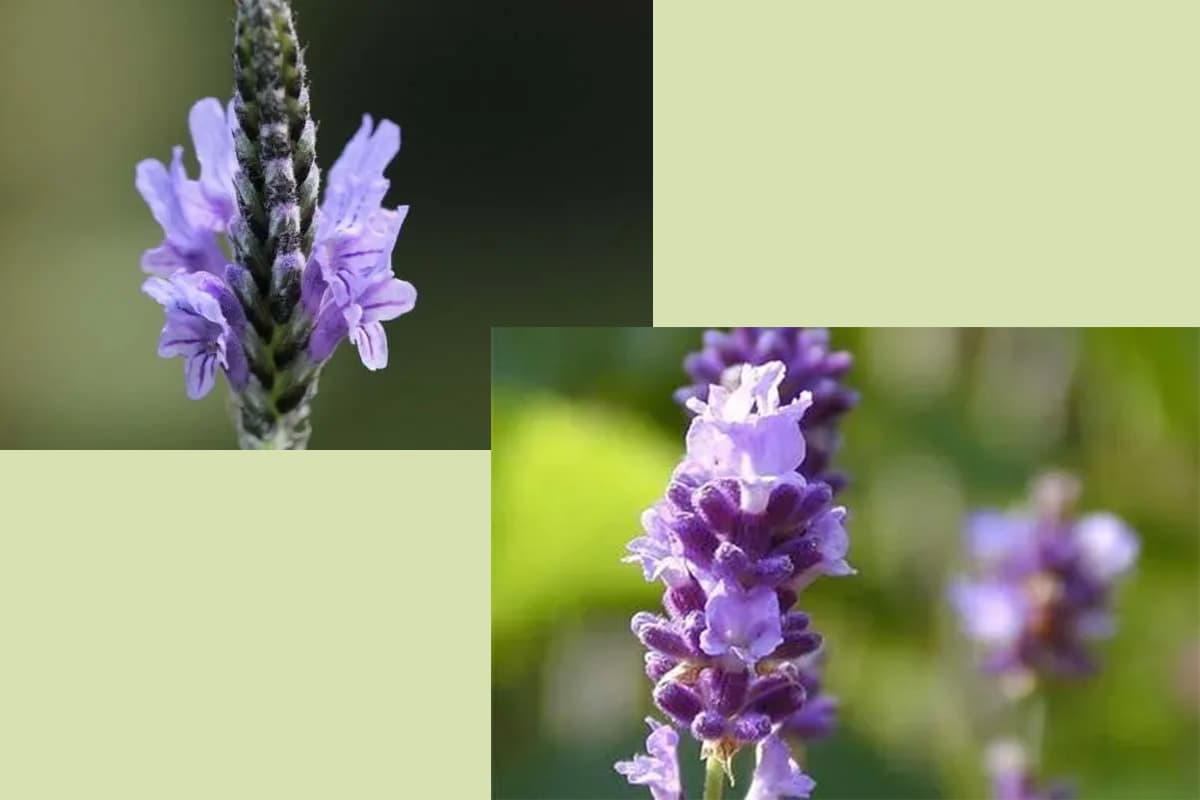
Lavandula pinnata, commonly known as Fernleaf Lavender or Feathered Lavender, is a distinctive shrub belonging to the Lamiaceae (mint) family. This evergreen perennial typically grows to a height of 30-100 cm (1-3 feet), with a spreading habit that can reach up to 1 meter in width.
The plant’s most distinguishing feature is its foliage. The leaves are bipinnately lobed, meaning they are twice divided, giving them a delicate, fern-like appearance. These leaves are arranged oppositely on the stem and possess a grayish-green coloration, which contributes to the plant’s overall silvery appearance. The foliage is highly aromatic, releasing a characteristic lavender scent when touched or crushed.
Flowering occurs throughout the year, with peak blooming from late autumn (November) through late spring or early summer (May-June). The inflorescences are composed of deep purple, tubular flowers arranged in whorls along elongated spikes. Each flower exhibits a bilabiate (two-lipped) structure, with the upper lip more prominent than the lower. Distinctive deep-colored streaks mark the petals, adding visual interest. Interestingly, unlike many lavender species, the flowers of L. pinnata are not strongly scented.
Native to the Macaronesian region, particularly the Canary Islands and Madeira, Lavandula pinnata has adapted to Mediterranean-like climates. It thrives in full sun exposure but benefits from partial shade during the hottest parts of summer in warmer regions. This species demonstrates good heat tolerance but may enter a period of dormancy during extremely hot summers.
For optimal growth, Fernleaf Lavender requires well-draining soil. It is particularly intolerant of wet, heavy soils, which can lead to root rot. The plant is considered semi-hardy, tolerating brief periods of light frost but requiring protection in colder climates.
In landscaping, Lavandula pinnata offers versatile applications. Its compact size and attractive foliage make it an excellent choice for underplanting trees and shrubs, creating textural contrast in mixed borders. It can be effectively used in transitional zones between lawns and garden beds, along roadsides, or as a focal point in small garden squares. The plant’s drought tolerance once established makes it suitable for water-wise gardens and xeriscaping.
When incorporated into flower beds or borders, Fernleaf Lavender provides a soft, airy texture that complements both bold-leaved plants and other fine-textured species. Its long blooming period ensures extended visual interest, while its aromatic foliage adds sensory appeal to the garden. Additionally, the plant attracts pollinators, contributing to the ecological value of the landscape.
For maintenance, regular pruning after flowering helps maintain the plant’s shape and encourages bushier growth. While generally pest-resistant, vigilance against common lavender pests such as spittlebugs and whiteflies is advisable.
In conclusion, Lavandula pinnata is a unique and attractive lavender species that offers year-round interest through its distinctive foliage and prolonged flowering period. Its adaptability to various garden settings, coupled with its low maintenance requirements, makes it an excellent choice for both novice and experienced gardeners seeking to add texture and Mediterranean charm to their landscapes.
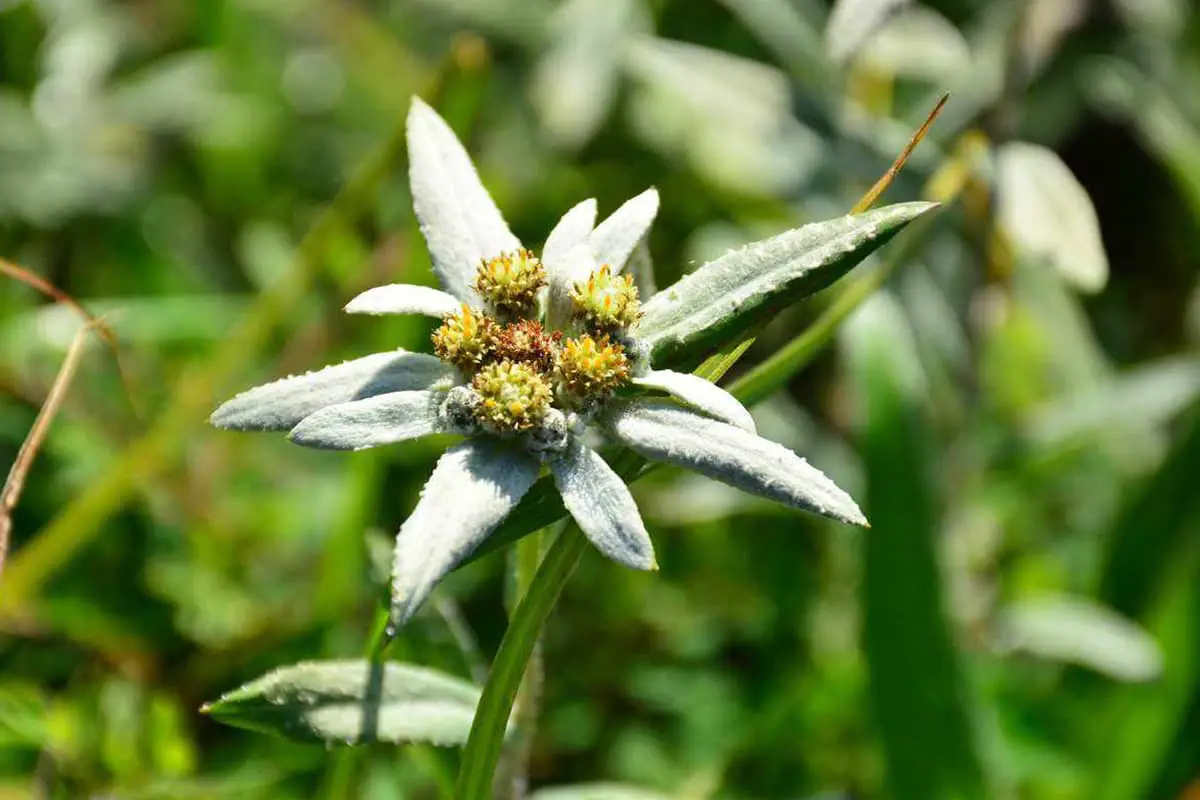
Leontopodium leontopodioides, commonly known as the Lion’s Foot or Asian Edelweiss, is a perennial herbaceous plant belonging to the Asteraceae family. This species is often confused with the European Edelweiss (Leontopodium nivale), but it is a distinct species with its own unique characteristics.
The plant features a robust rhizomatous root system, which contributes to its perennial nature and ability to thrive in challenging alpine conditions. Unlike its European counterpart, L. leontopodioides lacks a basal rosette of leaves, instead producing short, sheathed leaves along its stem.
The stem is erect, ranging from 5 to 45 cm in height, and is densely covered with long, soft, white hairs, giving the plant a woolly appearance. This pubescence serves as an adaptation to protect against harsh alpine conditions, including intense UV radiation and extreme temperature fluctuations.
Leaves are sessile (without stalks) and alternate along the stem. They are linear to lanceolate in shape, lacking sheaths, and are densely covered with white woolly hairs on both surfaces. This thick covering of hairs helps reduce water loss and protects the plant from cold temperatures.
The inflorescence consists of several (typically 3-7) closely packed flower heads, forming a cluster at the top of the stem. These are surrounded by distinctive bracts that are either rectangular or linear in shape and covered with thick white or grayish-white hairs. The bracts may form a loose cluster but are not arranged in distinct whorls.
Each individual flower head (capitulum) contains numerous tiny florets. The pappus, a modified calyx that aids in seed dispersal, consists of white hairs with a characteristic yellow base. The fruit is an achene, which may have a small nipple-like projection or be covered in dense, coarse hairs.
L. leontopodioides has a wide flowering and fruiting period, typically from July to October, adapting to the short growing seasons of its native habitats.
This species is native to various high-altitude regions across Asia, including Mongolia, North Korea, Japan, Russia, and China. It’s also found in parts of Europe and South America. The plant thrives in a range of alpine and subalpine habitats, from 100 to 3200 meters above sea level. It can be found in arid grasslands, loess slopes, gravelly areas, and mountain meadows, occasionally growing in slightly moist areas as well.
L. leontopodioides is well-adapted to harsh mountain environments. It prefers full sun exposure and can tolerate cold temperatures and drought conditions. The plant is also capable of growing in poor, rocky soils, making it an excellent choice for rock gardens or alpine plant collections.
In horticulture, L. leontopodioides is prized for its ornamental value. It’s suitable for rock gardens, alpine troughs, and can be grown in pots. The plant’s distinctive woolly appearance and star-shaped flower clusters make it an attractive addition to any garden attempting to recreate an alpine aesthetic. Its flowers can also be dried and used in floral arrangements or other decorative purposes.
Medicinally, L. leontopodioides has been used in traditional Asian medicine. The above-ground parts of the plant are believed to have antipyretic (fever-reducing), hemostatic (blood-cooling), and diuretic properties. It has been traditionally used to treat various conditions including epidemic colds, acute and chronic nephritis, urethritis, and urinary tract infections. The whole plant is also used in the treatment of proteinuria and hematuria, although scientific studies validating these uses are limited.
As with many alpine species, L. leontopodioides faces threats from climate change and over-collection in its natural habitats. Conservation efforts and sustainable cultivation practices are important for preserving this unique and valuable species for future generations.
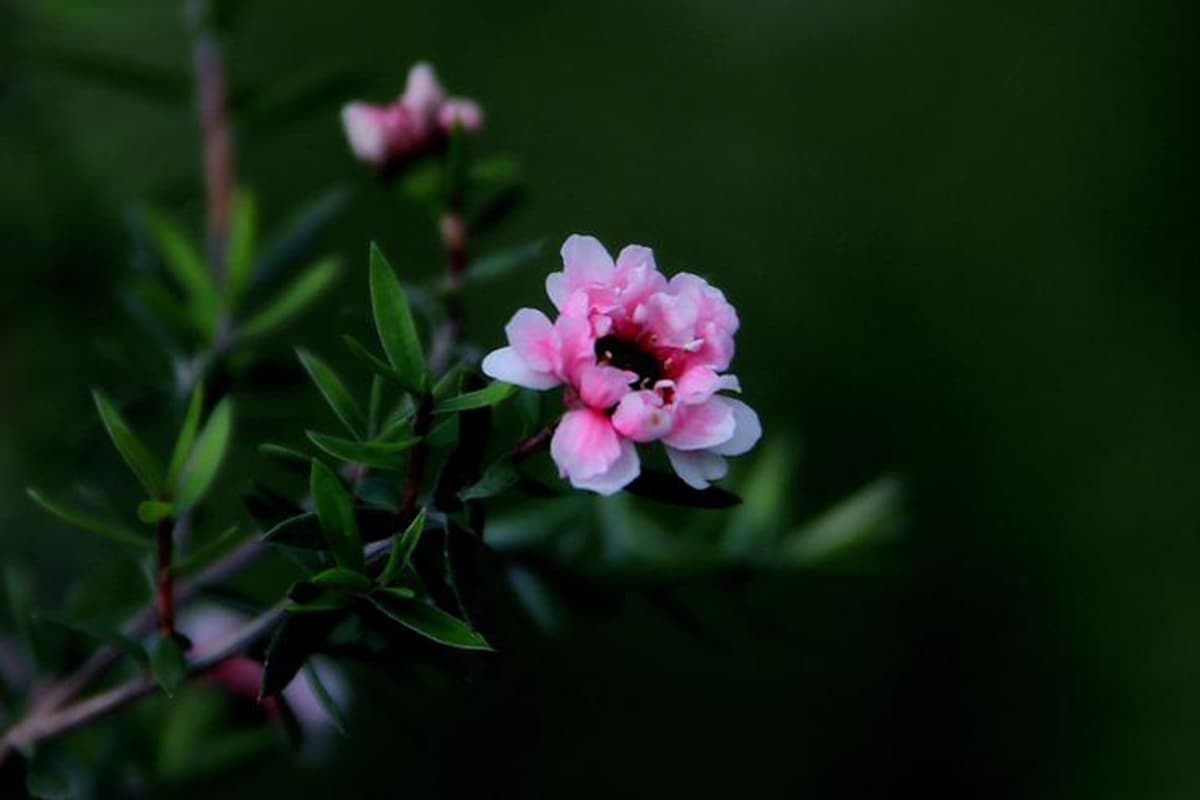
Leptospermum scoparium, commonly known as Manuka or Tea Tree, is a resilient evergreen shrub belonging to the Myrtaceae family. This species is characterized by its dense branching structure, featuring slender stems with a distinctive reddish-brown bark.
The young shoots of L. scoparium are typically adorned with fine, downy hairs, a feature that aids in water conservation and protection from harsh sunlight. Its leaves are small, opposite, and aromatic, ranging from linear to lanceolate in shape. This foliage arrangement maximizes light capture while minimizing water loss, adaptations crucial for its native environments.
Manuka flowers exhibit remarkable diversity in form and color. They can be single or double-petaled, with hues varying from pure white to various shades of pink, red, and peach. This color range, combined with their star-like shape, makes them visually striking and attractive to pollinators. The flowering period is extensive, spanning from late autumn through spring, providing a long-lasting display and extended nectar source for wildlife.
The fruit of L. scoparium is a small, woody capsule, often referred to as a “tea tree.” These capsules are leathery in texture and split open upon maturity to release numerous tiny seeds, an efficient dispersal mechanism that contributes to the plant’s widespread distribution.
Native to New Zealand and southeastern Australia, Manuka has successfully naturalized in parts of Southeast Asia, including Malaysia and Indonesia. This adaptability speaks to its resilience and ecological versatility. The plant thrives in warm, humid climates with ample sunlight, typically found in coastal and lowland areas up to subalpine regions in its native range.
While Manuka prefers well-draining, acidic soils rich in organic matter, it demonstrates remarkable soil tolerance, often pioneering in poor or disturbed soils. This adaptability makes it valuable for land rehabilitation projects. However, it’s important to note that L. scoparium has limited cold tolerance, which restricts its cultivation in temperate regions without protection.
Propagation of Manuka can be achieved through various methods. Softwood cuttings taken in late spring or early summer are most successful. Layering is another effective vegetative method, while seed propagation, though slower, produces genetically diverse offspring.
The medicinal properties of Manuka have garnered significant attention in recent years. The essential oil extracted from its leaves contains unique compounds, particularly β-triketones, which exhibit potent antimicrobial activities against a wide range of pathogens. This oil is particularly effective against antibiotic-resistant bacteria, making it valuable in modern medicine. Additionally, Manuka honey, produced by bees feeding primarily on Manuka flowers, is renowned for its exceptional antibacterial properties and wound-healing capabilities.
In horticulture, cultivars with double flowers reminiscent of peonies have led to the nickname “Pine Leaf Peony,” combining its needle-like leaves with its showy blooms. This ornamental value, coupled with its low maintenance requirements, makes Manuka increasingly popular in garden designs, particularly in regions with suitable climates.
The cultural significance of Manuka extends beyond its practical uses. In the language of flowers, or floriography, it symbolizes victory, determination, and promotion. This symbolism likely stems from the plant’s resilience and its ability to thrive in challenging conditions, making it an apt metaphor for overcoming obstacles and achieving success.
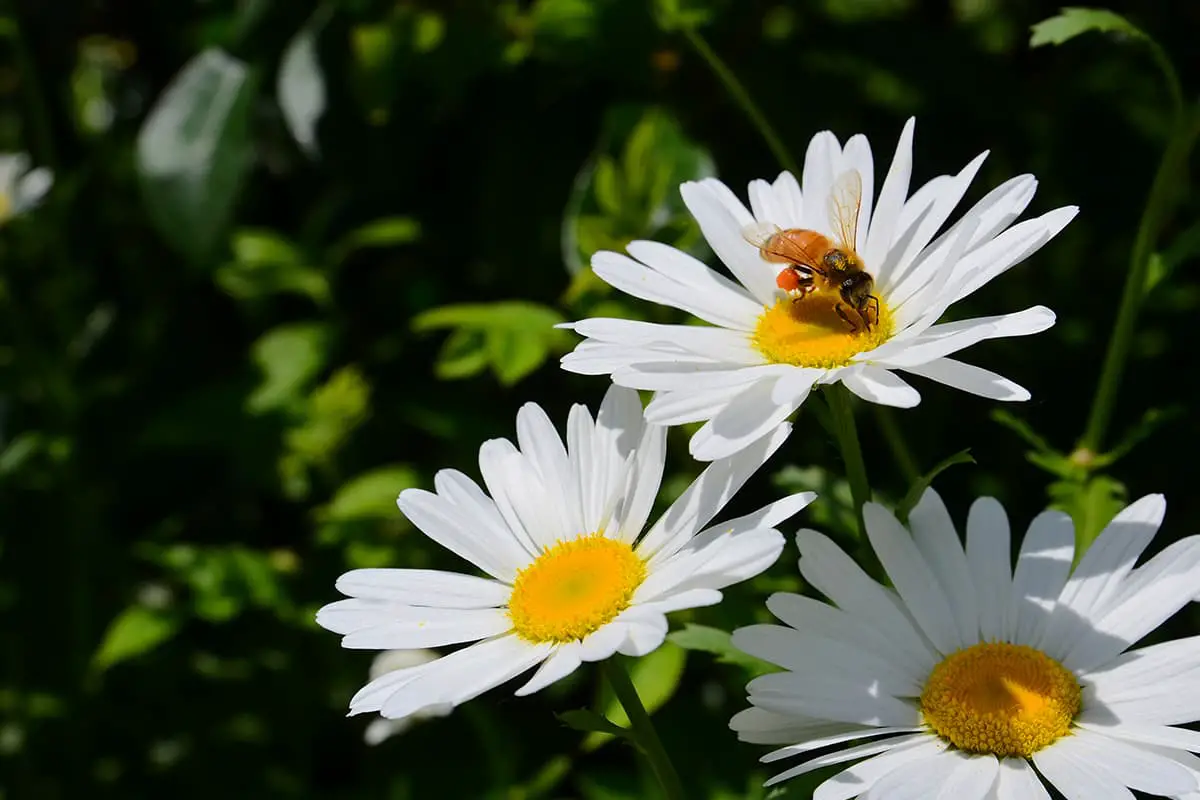
Leucanthemum maximum, commonly known as the Shasta daisy or max chrysanthemum, is a striking perennial herbaceous plant belonging to the Asteraceae family. This robust species can reach heights of up to 90 cm (35 inches), featuring smooth, hairless foliage and an upright, slightly hairy stem.
The plant’s leaves are alternately arranged, exhibiting an elongated lanceolate shape with a distinctive rounded tip and a gradually tapering base. These leaves are typically dark green and have serrated edges, contributing to the plant’s overall texture and visual appeal.
Leucanthemum maximum produces large, showy flower heads that can measure up to 10 cm (4 inches) in diameter. Each inflorescence consists of a central yellow disc surrounded by pure white ray florets, creating the classic daisy appearance. The flower heads are borne individually atop long, sturdy stalks, which adds to their striking presence in the garden.
The involucral bracts, which encase the base of the flower head, are broadly oval with blunt tips and often have a papery, slightly brownish margin. This species typically flowers from early summer to early autumn, with peak blooming occurring from July to September in most climates.
Native to the Pyrenees mountain range in southwestern Europe, Leucanthemum maximum has been widely cultivated and naturalized across many temperate regions, including parts of China. It thrives in full sun exposure but can tolerate partial shade, particularly in hotter climates. While adaptable to various soil types, it performs best in well-draining, fertile soils with a pH range of 6.0 to 8.0.
The Shasta daisy’s versatility extends to its cultural requirements. It is drought-tolerant once established but benefits from regular watering during dry spells. This species exhibits good cold hardiness, typically surviving in USDA zones 5-9, and can withstand temperatures as low as -29°C (-20°F).
Leucanthemum maximum’s popularity in ornamental horticulture stems from several attractive qualities:
In garden design, Shasta daisies are versatile performers. They excel in perennial borders, cottage gardens, and naturalistic plantings. Their bright white flowers can serve as a unifying element in mixed beds or as a striking mass planting. Additionally, dwarf cultivars have been developed for use in container gardens and smaller spaces.
While generally robust, Leucanthemum maximum can be susceptible to certain pests and diseases, including aphids, slugs, leaf spots, and stem rot. Proper spacing to ensure good air circulation and avoiding overhead watering can help mitigate these issues.
In conclusion, Leucanthemum maximum’s combination of aesthetic appeal, extended bloom time, and adaptability make it a valuable addition to diverse garden settings, justifying its widespread cultivation and enduring popularity in ornamental horticulture.
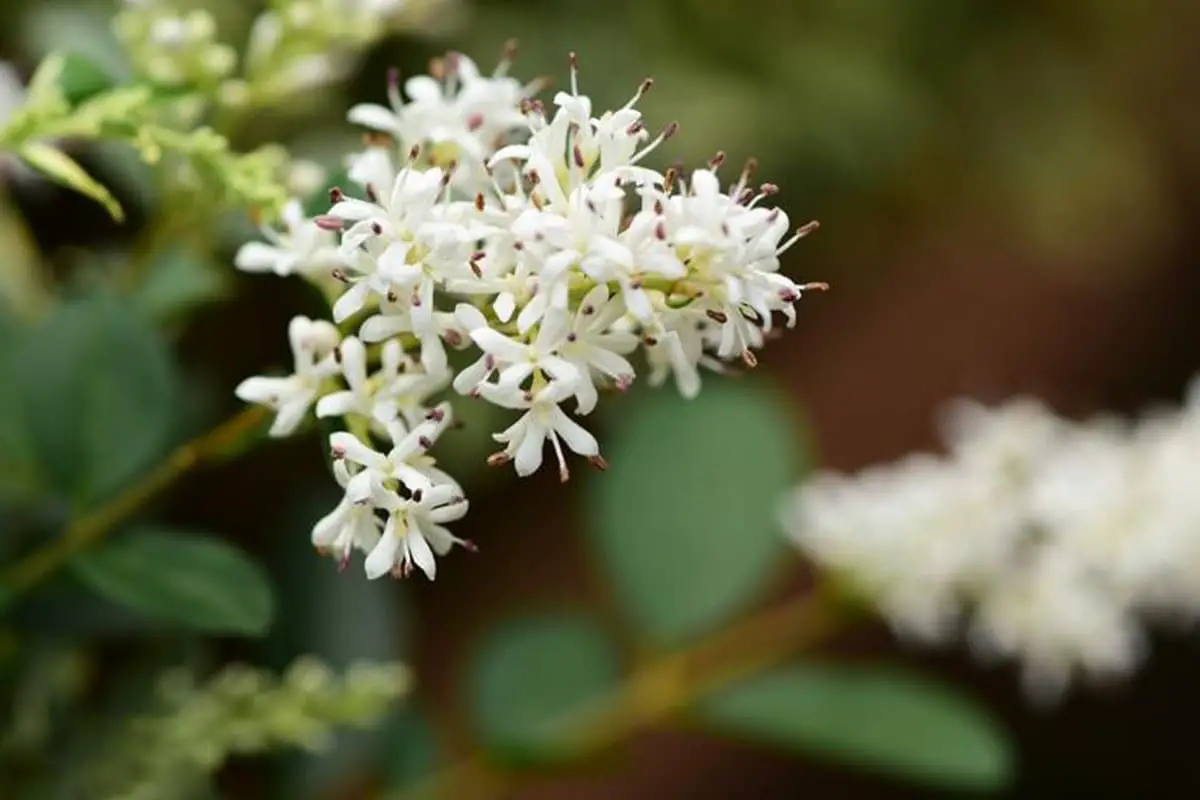
Ligustrum sinense, commonly known as Chinese Privet, is a versatile deciduous or semi-evergreen shrub belonging to the Oleaceae family. This adaptable plant typically grows 2-4 meters tall but can occasionally reach heights of up to 7 meters. Its growth habit is characterized by multiple stems and dense branching, making it an excellent choice for hedges and screens.
The twigs of Ligustrum sinense are cylindrical and initially covered with pale yellow pubescence, which gradually diminishes with age, resulting in nearly glabrous mature branches. This feature aids in identification, particularly in younger specimens.
Foliage is a key identifying characteristic of Chinese Privet. The leaves are oppositely arranged, papery to subcoriaceous in texture, and exhibit considerable morphological variation. Leaf shapes range from ovate to elliptic-ovate to linear-lanceolate, typically measuring 2-7 cm long and 1-3 cm wide. The leaf margins are entire, and the leaf surface is dark green and glossy above, with a paler underside.
The inflorescence of Ligustrum sinense is a distinctive panicle, either terminal or axillary, measuring 4-11 cm in length and 3-8 cm in width. These conical clusters bear numerous small, fragrant flowers, each about 4-6 mm in diameter. The flowers are creamy white, with four petals and two stamens, blooming profusely from late spring to early summer (March to June, depending on the climate).
Following flowering, Chinese Privet produces abundant fruit. These are nearly spherical drupes, 5-8 mm in diameter, initially green but ripening to a deep purple-black color. The fruits persist on the plant from September to December, providing winter interest and food for wildlife, although they can contribute to the plant’s invasive potential in some regions.
Native to China and Vietnam, Ligustrum sinense demonstrates remarkable ecological adaptability. It thrives in diverse habitats including hillsides, mountain valleys, roadsides, dense forests, sparse woods, and mixed woodlands. This species can be found at elevations ranging from 200 to 2600 meters above sea level, showcasing its tolerance to varied environmental conditions.
Chinese Privet has a long history of utilization in its native range. The fruit, rich in sugars and organic acids, can be fermented to produce alcohol. The seeds contain oil that, when pressed, is suitable for soap manufacturing, highlighting the plant’s potential in sustainable industry practices. Traditional Chinese medicine has long recognized the medicinal properties of Ligustrum sinense. The bark and leaves are used to reduce fever and inflammation, and to treat various ailments including hematemesis, toothaches, mouth ulcers, and pharyngitis.
In horticulture, Ligustrum sinense is widely cultivated as an ornamental plant, particularly prized for its use in formal hedges, screens, and topiary. Its dense growth habit, tolerance to pruning, and adaptability to various soil types make it a popular choice in landscape design. However, its vigorous growth and prolific seed production have led to its classification as an invasive species in some parts of the world, particularly in the southeastern United States, where it can outcompete native vegetation.
When considering Chinese Privet for cultivation, it’s essential to be aware of its potential for spread and to manage it responsibly. In suitable environments, regular pruning and proper disposal of trimmings can help control its growth and prevent unwanted dispersal.
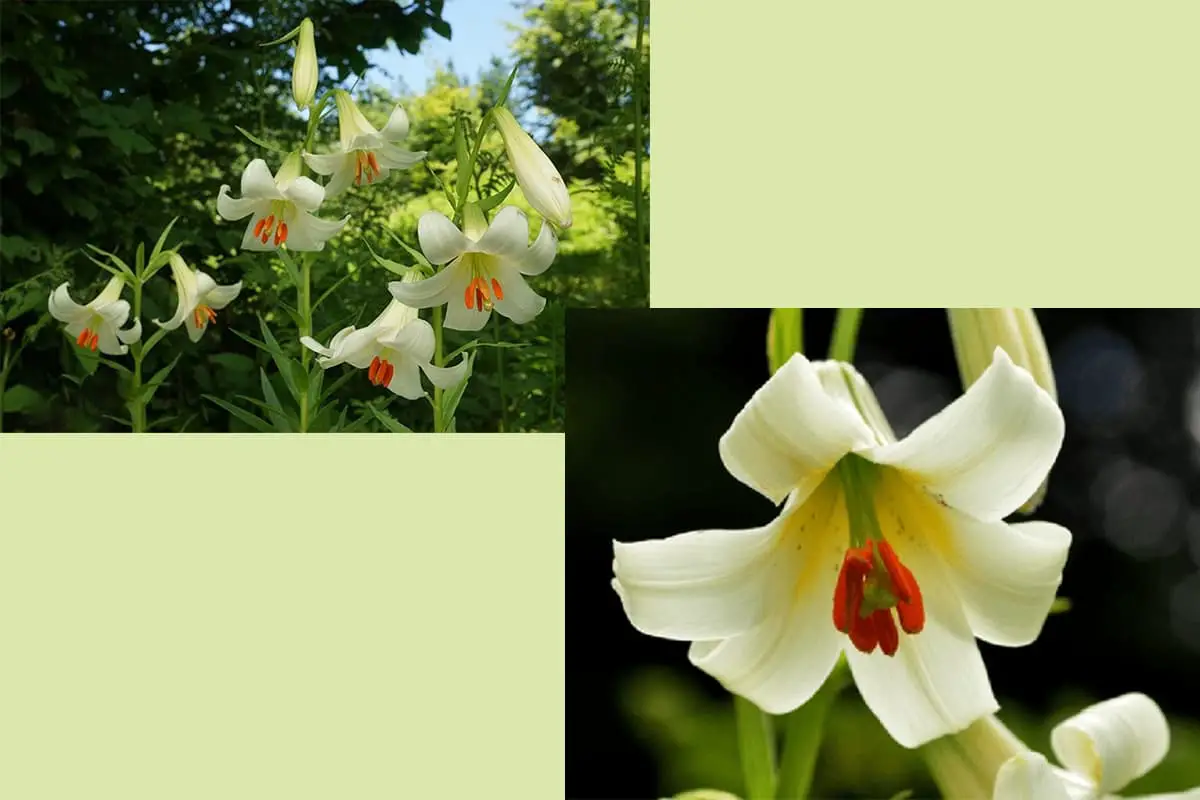
Lilium Akkusianum, a striking and rare species of lily, typically grows between 80-140 cm in height, with exceptional specimens reaching up to 180 cm. The bulb is characteristically egg-shaped to broad elliptical, measuring approximately 60 mm in height and 55 mm in width. It comprises several loosely arranged scales, varying from narrow ovate-lanceolate to lanceolate in shape.
The foliage of this lily is distinctive, with alternate leaves adorning the stem. These linear-lanceolate leaves measure about 21 cm in length and 3.5 cm in width, featuring a unique characteristic of woolly hairs along the margins and at the base, which aids in moisture retention and protection.
The flowers of Lilium Akkusianum are particularly noteworthy, exhibiting a bell-shaped form that measures up to 6 cm in length and 10 cm in diameter. These blooms emit a delightful fragrance reminiscent of lemon soap, adding to their ornamental value. The petals are spoon-shaped and recurve elegantly, creating a visually striking appearance.
The color palette of the flowers is quite variable. The base flower color typically ranges from ivory to pale yellow, adorned with fine purple spots that add depth and interest. The throat of the flower is a rich yellow, creating a beautiful contrast. In some variations, the entire flower may appear purple, showcasing the species’ genetic diversity.
Lilium Akkusianum is a true endemic species, found exclusively in Turkey. Its natural habitat is restricted to a few small areas on the forest edges near the city of Akkus in southeastern Turkey. This lily thrives at altitudes between 1100-1500 meters, demonstrating its adaptation to specific environmental conditions. It can be found in diverse ecosystems within this range, including beech forests, forest edges, meadows, and hedges.
The limited distribution of Lilium Akkusianum underscores its ecological significance and the importance of conservation efforts to protect this unique species. Its specific habitat requirements and limited range make it particularly vulnerable to environmental changes and highlight the need for targeted conservation strategies to ensure its long-term survival in its native ecosystem.
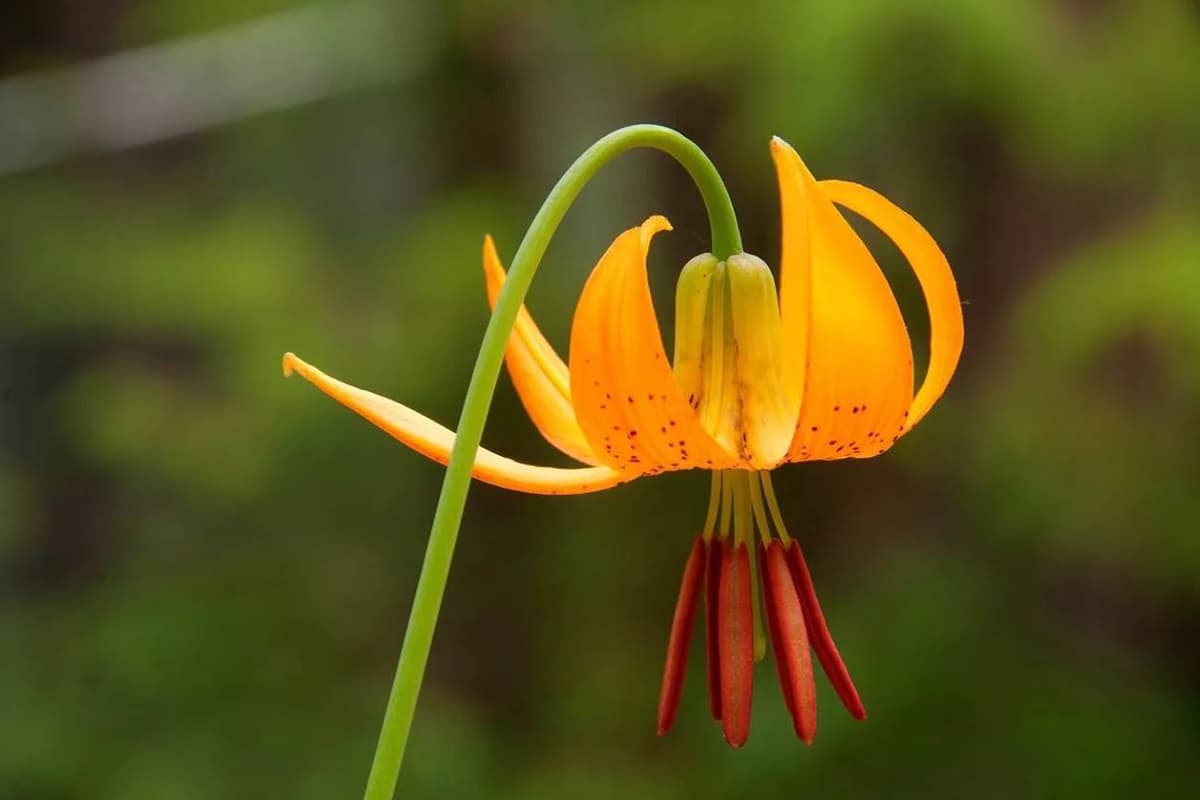
Lilium distichum Nakai, commonly known as the Two-Ranked Lily, is a distinctive perennial herbaceous plant belonging to the Liliaceae family. Its ovate bulb is characterized by lanceolate, white scales that are distinctly segmented, providing a strong foundation for the plant’s growth.
The stem of L. distichum is adorned with glabrous leaves concentrated in the middle portion, arranged in a sparse pattern. These leaves exhibit an obovate-lanceolate to elongated ovate-lanceolate shape, contributing to the plant’s elegant silhouette. The inflorescence is cymose, featuring leaf-like bracts that support the striking floral display.
The flowers of L. distichum are a captivating pale orange-red, adorned with purple-red spots that add depth and visual interest. A key identifying feature is the tepals (fused petals and sepals) which recurve gracefully, creating the classic “Turk’s cap” lily form. Notably, the nectar glands lack papillary protrusions on either side, distinguishing it from some related species. The floral structure is completed by glabrous filaments supporting linear anthers, and a style that extends to twice the length of the ovary, terminating in a spherical stigma.
This lily species follows a specific phenological pattern, with flowering occurring from July to August, followed by fruiting in September. The fruit takes on an obovoid shape, containing seeds that can be used for propagation alongside the more common method of bulb division.
Geographically, L. distichum is native to northeastern China, specifically the provinces of Jilin and Liaoning. It demonstrates remarkable adaptability, thriving in diverse habitats including forested slopes, woodland margins, roadsides, and riparian areas. The species has a wide altitudinal range, growing from 200 to 1800 meters above sea level. For optimal growth, it prefers fertile, well-draining sandy loam soils that mimic its natural habitat conditions.
In traditional Chinese medicine, the bulb of L. distichum is valued for its neutral nature and sweet taste. It is believed to possess properties that nourish yin, moisten the lungs, alleviate coughs, reduce phlegm, calm the heart, and soothe the mind. Beyond its medicinal applications, the bulb’s high starch content makes it suitable for culinary use or brewing purposes.
Horticulturally, L. distichum is prized for its unique form and robust, attractive stature. Its versatility in landscape design is noteworthy, as it can be effectively cultivated in various settings. It excels as an understory plant in woodland gardens, provides visual interest when planted among shrubs, and can serve as a striking focal point in dedicated flower beds. The species’ natural elegance and adaptability make it an excellent choice for both naturalistic and more formal garden designs.
For successful cultivation, gardeners should aim to replicate the plant’s preferred conditions: partial shade to dappled sunlight, consistent moisture without waterlogging, and rich, well-draining soil. Regular feeding during the growing season and protection from strong winds will help ensure healthy growth and abundant flowering. With proper care, Lilium distichum Nakai can become a stunning and long-lived addition to diverse garden landscapes.
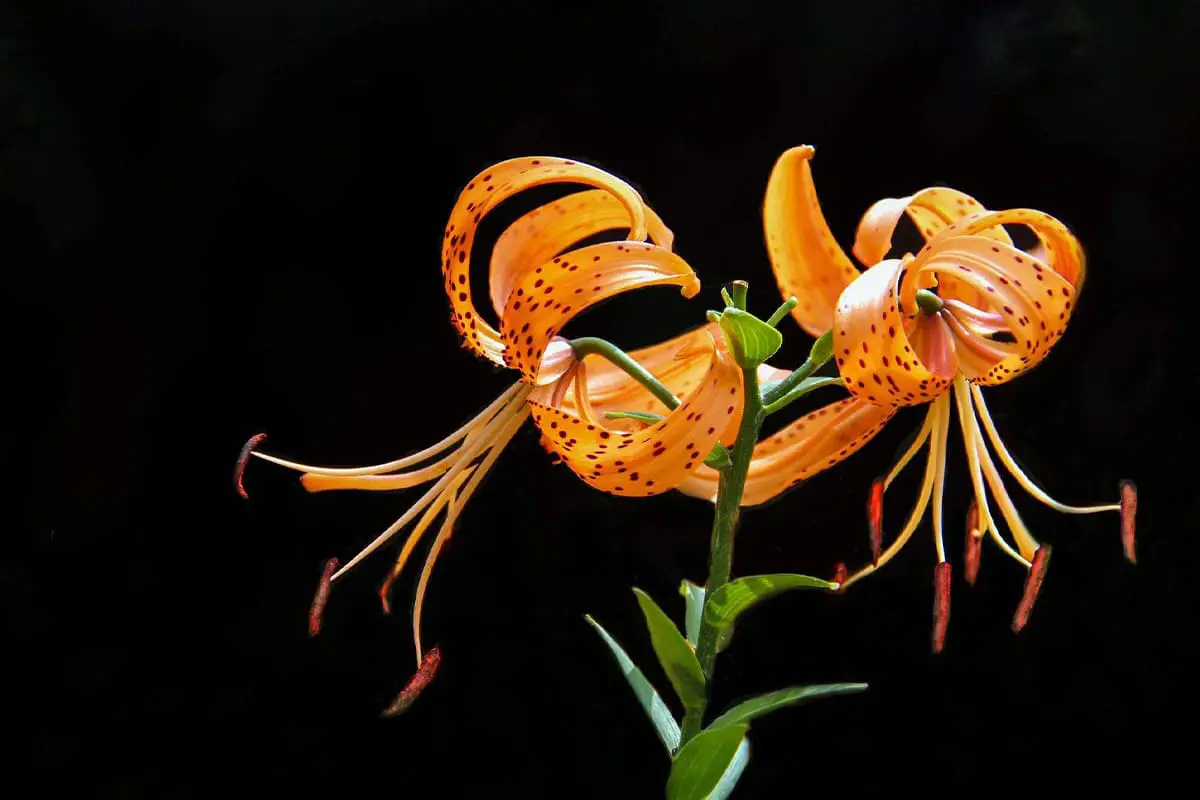
Lilium lancifolium, commonly known as the Tiger Lily, is a striking perennial bulbous plant belonging to the Liliaceae family. Its distinctive fiery orange-red petals that dramatically curl backwards give rise to its evocative common name. The bulb is characteristically broad, with an ovate-flattened spheroid shape and broad ovate scales.
The stem of L. lancifolium is notable for its purple striations and fine white hairs. The leaves are elongated, ranging from ovate-lanceolate to lanceolate in shape. While mostly glabrous on both surfaces, they feature distinctive papillary protrusions along the margins. A unique characteristic of this species is the presence of bulbils in the axils of the upper leaves, which serve as a means of asexual reproduction.
The inflorescence is adorned with leaf-like, ovate-lanceolate bracts. The flowers themselves are a spectacle, with their backward-curling tepals displaying a vibrant orange-red hue, beautifully accented by purple-black spots. The ovary is cylindrical, developing into an elongated ovate fruit. Flowering typically occurs from July to August.
Native to East Asia, including China, Japan, and Korea, L. lancifolium thrives in specific environmental conditions. It prefers light, cool, and relatively dry habitats. While cold-resistant, it is sensitive to excessive heat and moisture. The species shows a predilection for clayey soils and is commonly found growing under shrubs, in meadows, along roadsides, or near water sources. It has a wide altitudinal range, flourishing from 400 to 2500 meters above sea level.
Propagation of L. lancifolium is primarily achieved through bulb division, though the axillary bulbils can also be utilized for this purpose, offering an efficient method of vegetative reproduction.
Beyond its ornamental value, L. lancifolium holds significant medicinal importance in traditional Eastern medicine. The bulb, characterized by a mild bitterness and neutral properties, is believed to nourish yin, moisturize the lungs, calm the heart, and soothe the mind. It is traditionally employed in treating various ailments, including chronic coughs associated with yin deficiency, hemoptysis, restlessness, insomnia, frequent dreaming, and absent-mindedness.
The versatility of L. lancifolium extends to its culinary applications. The bulb, rich in starch, is edible and has been used as a food source in its native range. Furthermore, the flowers contain aromatic oils that have potential applications in the fragrance industry.
In horticulture, L. lancifolium is prized for its robust nature and stunning flowers, making it a popular choice for gardens and landscapes. Its ability to naturalize in suitable conditions and its relatively low maintenance requirements add to its appeal for both novice and experienced gardeners alike.

Lilium longiflorum, commonly known as the Easter Lily, is a striking perennial bulbous plant belonging to the Liliaceae family. Its nearly spherical bulb is composed of white, fleshy scales that serve as food storage organs. The erect stem, typically ranging from 60-120 cm in height, is a vibrant green with a distinctive pale red base.
The foliage of L. longiflorum is characterized by sparsely arranged, lanceolate to linear-lanceolate leaves. These leaves, 10-15 cm long and 1-2 cm wide, are dark green, glossy, and hairless on both surfaces, tapering to a pointed tip. This arrangement allows for optimal sunlight absorption and efficient photosynthesis.
The flowers are the plant’s most captivating feature. They are large (15-20 cm long), fragrant, and trumpet-shaped, typically pure white with a slight greenish tinge on the outer surface of the perianth tube. The blooms can be solitary or appear in clusters of 2-3, facing outward or slightly nodding. Each flower comprises six tepals, six stamens with prominent yellow anthers, and a single pistil with a three-lobed stigma.
Flowering occurs from late spring to early summer (May to July in the Northern Hemisphere), with the fruiting period following from mid to late summer (July to September). The fruit is an oblong capsule containing numerous flat, winged seeds.
Native to the southern islands of Japan (including the Ryukyu Islands) and Taiwan, L. longiflorum thrives in full sun to partial shade. While it prefers warm temperatures during its growing season, it requires a period of cold dormancy (around 4-10°C) for proper bulb development and subsequent flowering. The plant is hardy to USDA zones 5-9 but may need winter protection in colder regions.
For optimal growth, L. longiflorum requires well-draining, fertile soil rich in organic matter. The ideal pH range is slightly acidic to neutral (6.0-7.0). A deep, humus-rich, sandy loam provides the best growing conditions. Heavy clay or highly alkaline soils should be avoided or amended significantly before planting.
Propagation of L. longiflorum can be achieved through several methods:
Beyond its ornamental value, L. longiflorum has several medicinal applications in traditional Chinese and Japanese medicine. The bulb and flowers are considered to have cooling properties with a slightly sweet and bitter taste. They are used to:
In Western horticulture, the Easter Lily holds significant cultural importance. Its association with Easter stems from its natural blooming period coinciding with the holiday, as well as its white color symbolizing purity and rebirth. This timing has made it a popular choice for Easter decorations and gifts.
The fragrance of L. longiflorum is highly prized in the perfume industry. Its essential oil, extracted through solvent extraction or enfleurage, is used in high-end fragrances and cosmetics, adding a rich, sweet, and slightly spicy floral note.
In cultivation, attention must be paid to potential pests and diseases, including aphids, bulb mites, and various fungal infections such as Botrytis. Proper spacing, good air circulation, and careful watering practices can help prevent many of these issues.
As a testament to its horticultural significance, numerous cultivars of L. longiflorum have been developed, varying in height, flower size, and blooming time, allowing for its wide use in landscapes, cut flower arrangements, and potted plant production.
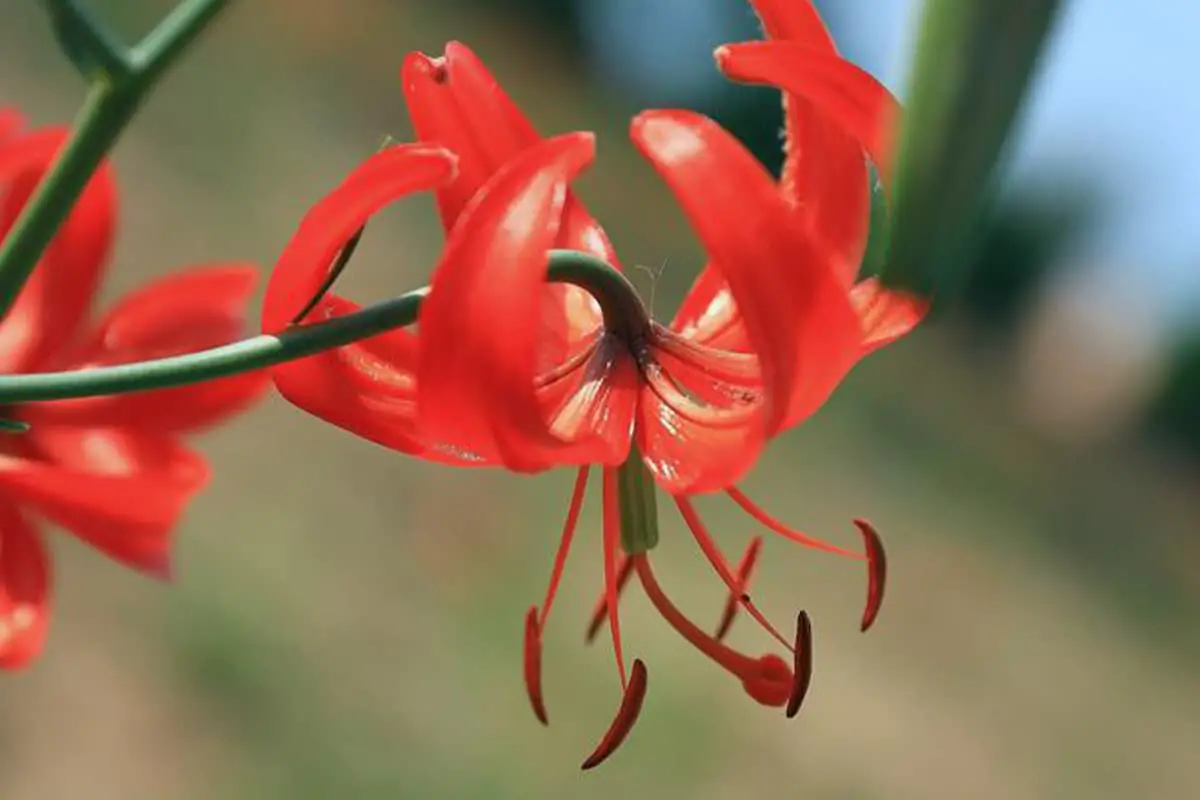
Lilium pumilum, commonly known as the Coral Lily or Dwarf Lily, is a striking perennial herbaceous plant belonging to the Liliaceae family. Its bulb is typically ovoid or conical, composed of numerous white, elongated oval to lanceolate scales.
The stem, slender and erect, reaches heights of 30-80 cm. The leaves are linear, 3-8 cm long and 2-5 mm wide, with distinctive papillary protrusions along the margins. They are arranged alternately and somewhat sparsely around the middle portion of the stem, becoming progressively smaller towards the apex.
The flowers of Lilium pumilum are its most captivating feature. Bright coral-red to orange-red in color, they are usually unspotted, though occasionally faint spots may appear. The tepals, measuring 3-5 cm in length, curve backward dramatically (recurved), giving the flower its characteristic shape. Each flower possesses six stamens with prominent orange anthers and a single pistil with a three-lobed stigma. A unique characteristic is the presence of papillary protrusions on either side of the nectaries, located at the base of each tepal.
Flowering occurs from late June to August, depending on the altitude and local climate. The fruit, an elongated oval capsule, develops and matures between September and October.
Lilium pumilum has a wide distribution across Northeast Asia. It is found throughout much of China, including provinces such as Hebei, Heilongjiang, Jilin, Liaoning, Nei Mongol, and Shanxi. Beyond China, it extends into eastern Russia, North Korea, and Mongolia.
This species demonstrates remarkable adaptability to various environmental conditions. It thrives in mild, moist climates but shows considerable tolerance to cold, drought, poor soil conditions, and even saline-alkaline soils. Optimal growth occurs in organically rich, loose, fertile, well-draining slightly acidic soils or sandy loam. Lilium pumilum is often found on mountain slopes, in grasslands, or at forest edges, typically at elevations ranging from 400 to 2600 meters above sea level.
Despite its wide distribution and adaptability, Lilium pumilum is listed as “Least Concern” (LC) on the IUCN Red List, indicating that it is not currently at risk of extinction. However, like many wild species, it may face localized threats from habitat loss and over-collection.
Propagation of Lilium pumilum is commonly achieved through bulb division and scale cuttings. Bulb division is best performed in early autumn or early spring when the plant is dormant. Scale cuttings can be taken throughout the growing season, with best results typically achieved in late summer to early fall.
In traditional Chinese medicine, Lilium pumilum has been utilized for its therapeutic properties. The bulb, known as “Bai He” in Chinese herbal medicine, is believed to moisten the lungs, alleviate coughs, clear heat, and calm the mind. It is often prescribed for conditions such as chronic cough due to lung weakness, hemoptysis, restlessness, and edema. The efficacy and safety of these traditional uses should be considered in the context of modern medical research.
Nutritionally, the bulb of Lilium pumilum is rich in starch, proteins, and inorganic salts, offering good nourishing properties. In some cultures, it is used as a food source and can add both nutritional value and visual appeal to dishes.
The flowers of Lilium pumilum contain essential oils that can be extracted for use in perfumery, although this is not a common commercial practice due to the plant’s relatively limited availability.
In the language of flowers, Lilium pumilum symbolizes perseverance in the face of adversity, likely due to its ability to thrive in challenging environments. Its vibrant blooms are also associated with beauty and happiness, making it a meaningful addition to gardens and floral arrangements.
For cultivation, Lilium pumilum prefers full sun to partial shade and requires well-draining soil to prevent bulb rot. It’s an excellent choice for rock gardens, borders, or naturalized areas in temperate climates. Its compact size and brilliant flowers make it particularly suitable for smaller gardens or container planting.

Lilium speciosum, commonly known as the “Showy Lily” or “Japanese Show Lily,” is a striking member of the Liliaceae family. This elegant perennial typically grows to a height of 60-120 cm (2-4 ft), featuring a sturdy stem adorned with scattered leaves that exhibit variations in shape, including broad lanceolate, oblong-lanceolate, or ovate-lanceolate forms.
The plant’s distinctive flowers, usually numbering 1-5 per stem, are arranged in a racemose or nearly umbellate inflorescence. These large, fragrant blooms are characterized by their downward-facing orientation and dramatically reflexed tepals with undulating edges. The flowers are primarily white, embellished with reddish-purple spots and patches covering the lower 1/2 to 1/3 of each tepal, creating a striking visual contrast.
Lilium speciosum blooms from July to August, producing nearly spherical, light brown capsules as fruits in October. As the fruit matures, the peduncle noticeably swells, a characteristic feature of this species.
This lily species thrives in cool, moist environments and demonstrates remarkable shade tolerance and cold resistance. It performs optimally in temperatures ranging from 15 to 25°C (59-77°F), preferring fertile, humus-rich soils with deep layers and excellent drainage. Slightly acidic soil conditions (pH 6.0-6.5) are ideal for its growth. Lilium speciosum is particularly averse to drought, excessive heat, and heavy clay soils.
In its natural habitat, Lilium speciosum is commonly found in damp forests and on grassy slopes at elevations between 650-900 meters (2,130-2,950 ft) above sea level. This species is native to southern Japan and has been widely cultivated for its ornamental value and, to some extent, for traditional medicinal uses.
For successful cultivation, provide partial shade, consistent moisture without waterlogging, and rich, well-draining soil. Regular fertilization during the growing season and mulching to maintain soil moisture and temperature can significantly enhance its growth and flowering performance. With proper care, Lilium speciosum can be a stunning addition to woodland gardens, mixed borders, or container displays, offering both visual appeal and a delightful fragrance in late summer landscapes.

Lilium tigrinum, commonly known as the Tiger Lily, is a striking member of the Liliaceae family. Its underground stem consists of a large, white bulb without visible nodules. The aerial stem is often adorned with purple stripes and is glabrous (hairless).
The leaves are arranged in a scattered pattern along the stem, with upper leaves typically smaller than those in the middle. These lanceolate leaves have smooth margins and are glabrous, featuring short petioles. The flowers are trumpet-shaped and fragrant, predominantly white with purple-brown coloration on the exterior. Unlike the common tiger lily, this species lacks spots on its petals.
The flower tepals recurve at the tips but do not fully curl. The fruit is an oblong capsule with distinct edges, containing numerous seeds. Flowering and fruiting occur from June to September.
Lilium tigrinum thrives in diverse habitats, including grassy slopes, open woodlands, along mountain streams, roadside verges, and near human settlements. It grows at elevations ranging from 300 to 920 meters above sea level. This species demonstrates high adaptability, preferring cool, moist, and partially shaded environments. It exhibits cold hardiness and is classified as a long-day plant, requiring extended periods of daylight to initiate flowering.
Propagation can be achieved through both sexual (seeds) and asexual methods. In cultivation, asexual propagation techniques such as scaling, bulblets, and bulbils are more commonly employed due to their efficiency and consistency.
In Chinese culture, the lily symbolizes family harmony and enduring love. Interestingly, in Western Christian iconography, the lily was originally depicted as yellow, representing the purity of the Virgin Mary, before evolving to its more familiar white representation.
Lilies are highly valued in horticulture for their elegant appearance and lush, delicate foliage. The fresh flowers contain essential oils suitable for perfumery. The bulbs, rich in starch, are considered a delicacy in some cuisines and also possess medicinal properties.
In traditional Chinese medicine, Lilium tigrinum is attributed with various therapeutic effects. It is believed to moisten the lungs, alleviate coughs, clear heat, calm the spirit, and promote diuresis. Recent scientific research has also indicated potential anticancer properties, though further studies are needed to fully understand and validate these effects.

Lilium tsingtauense (Qingdao Lily) is a perennial herbaceous plant belonging to the Liliaceae family. It features a subglobose bulb with lanceolate, white scales that lack articulations.
The leaves are arranged in whorls, exhibiting varied shapes from oblong-lanceolate to lanceolate or elliptical. They are acuminate at the apex and broadly cuneate at the base. The leaves are sessile or have very short petioles and are glabrous on both surfaces. Bracts are foliaceous and lanceolate.
The flowers are either orange-yellow or orange-red, adorned with purplish-red spots. Tepals are oblong-elliptic, with nectaries on either side lacking papillae. Filaments are glabrous, supporting orange-yellow anthers. The ovary is cylindrical. Flowering occurs in June, with fruit formation in August.
Native to China’s Shandong and Anhui provinces, Lilium tsingtauense also extends its range to North Korea. It thrives on sunny mountain slopes within mixed forests or tall grasslands at elevations between 100-400 meters.
This species demonstrates remarkable adaptability, being highly cold-resistant and tolerant of various soil types. It can be cultivated in most environments, except extremely arid conditions. Propagation is primarily through seeds.
The bulb of Lilium tsingtauense is not only nutritious and edible as a vegetable but also possesses medicinal properties. In traditional medicine, it is used to moisten the lungs, suppress coughs, and calm the heart and mind. Its primary applications include treating lung diseases, hemoptysis, restlessness, and palpitations.
Horticulturally, Lilium tsingtauense is versatile and can be effectively used in various landscape settings. It is suitable for woodland gardens, open spaces, rock gardens, and as a border plant in grassy areas. It can be planted in groups or clumps for maximum visual impact.
For optimal growth, provide well-draining soil rich in organic matter, and ensure partial shade to full sun exposure. Regular watering during the growing season and mulching to retain soil moisture and suppress weeds will promote healthy growth. Divide bulbs every 3-4 years in early autumn to maintain vigor and prevent overcrowding.
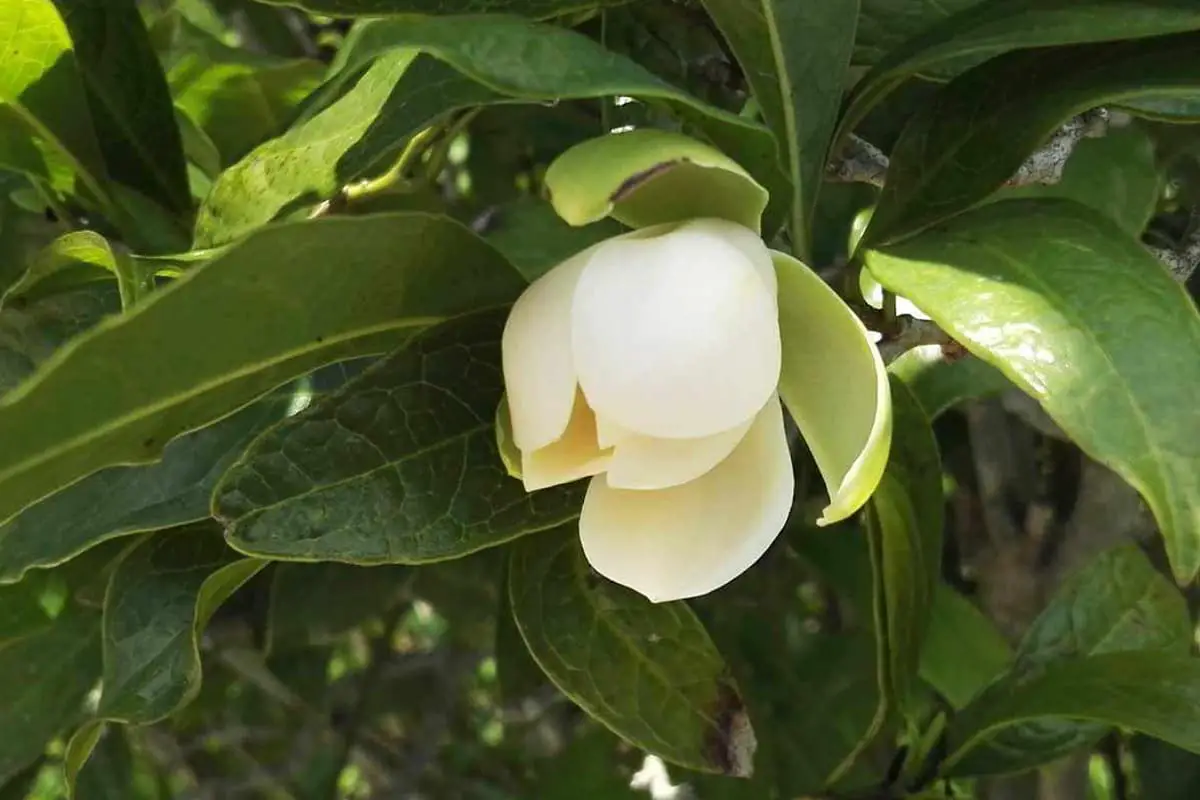
Lirianthe Coco, commonly known as Night Fragrant Magnolia or Michelia alba, is an evergreen shrub or small tree belonging to the Magnoliaceae family. This species is characterized by its glabrous nature, with all parts of the plant being hairless. The bark presents a gray coloration, while young branches exhibit a distinctive green hue.
The foliage of Lirianthe Coco is notably leathery in texture, displaying a variety of shapes including elliptical, narrow elliptical, or ovate-elliptical forms. These leaves contribute significantly to the plant’s ornamental value, providing a lush, deep green canopy that sways gracefully in the breeze.
The inflorescence of the Night Fragrant Magnolia is particularly noteworthy. The flower stalk exhibits a distinctive downward droop, supporting blooms that are spherically rounded or ovate with a concave belly. These pure white flowers are not only visually striking but also possess an intensifying fragrance as night falls, a characteristic that has made this species a prized ornamental tree in South China gardens for centuries.
Flowering typically occurs during the summer months, followed by fruit development in autumn. The seeds are ovate in shape, with the inner seed coat displaying a brown coloration and featuring a lateral hole on the belly end, an important identifying characteristic for this species.
Native to China, Lirianthe Coco has been widely cultivated throughout Southeast Asia, including Vietnam. This species demonstrates specific environmental preferences that are crucial for its optimal growth and development. It thrives in warm, moist environments with a balance of partial sunlight and shade. The ideal soil conditions for Night Fragrant Magnolia include well-draining, fertile, slightly acidic sandy soils. It’s important to note that this species shows an aversion to calcareous soils, which can impede its growth.
Propagation of Lirianthe Coco is primarily achieved through vegetative methods. These include layering, where a stem is encouraged to root while still attached to the parent plant; grafting, which involves joining plant tissues of two different plants; and cuttings, where a portion of the stem is removed and encouraged to root independently.
Beyond its ornamental value, Lirianthe Coco has garnered attention for its potential medicinal properties. The plant contains novel resins that have shown promise in the treatment of liver damage, certain types of cancer, and headaches. However, it’s important to note that more research is needed to fully understand and validate these potential medical applications.
In cultivation, attention should be paid to maintaining the plant’s preferred growing conditions. Regular pruning can help maintain the desired shape and promote healthy growth. Additionally, while the species is generally hardy, it may benefit from protection against extreme cold in regions at the edge of its hardiness zone.
The Night Fragrant Magnolia stands as a testament to the harmonious blend of aesthetic beauty and potential utility in the plant kingdom, making it a valuable addition to both ornamental gardens and the broader field of botanical research.
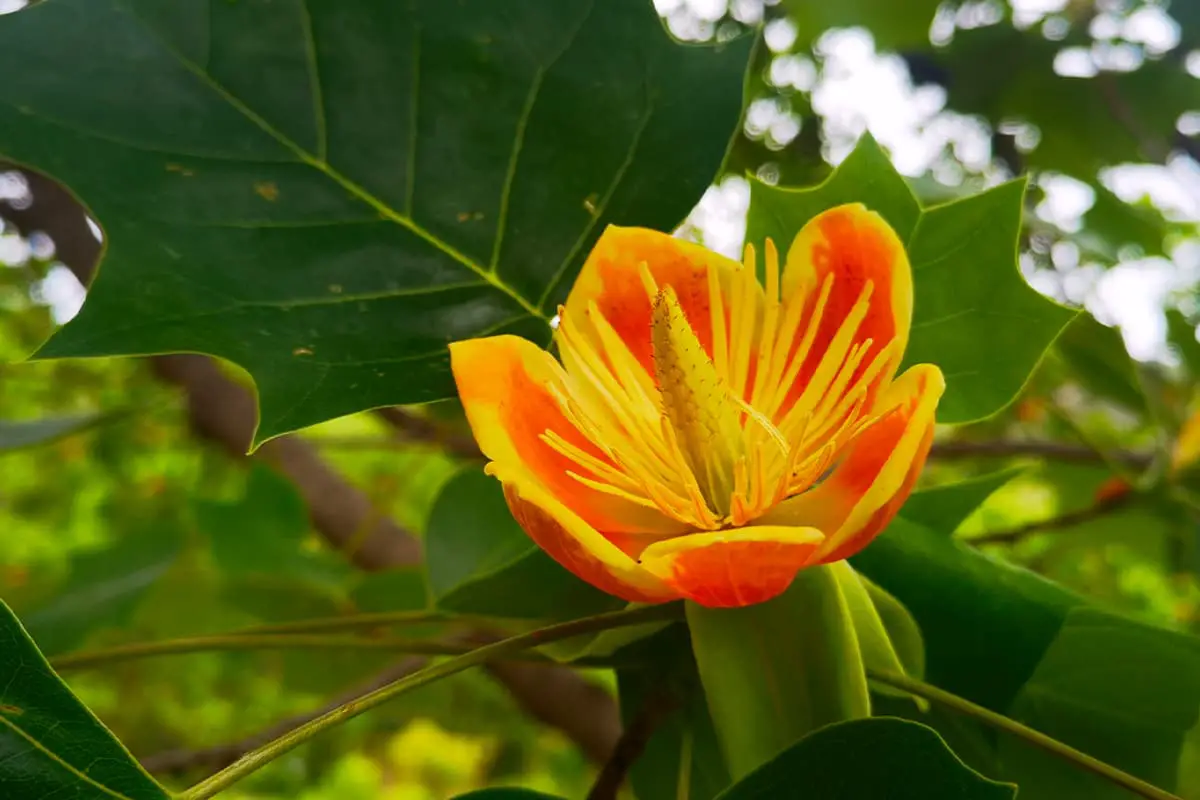
Liriodendron chinense (Chinese Tulip Tree), a member of the Magnoliaceae family, is a magnificent deciduous tree that can attain heights of up to 40 meters with a diameter at breast height (DBH) exceeding 1 meter. The tree is characterized by its straight trunk and distinctive umbrella-shaped crown. Its small branches exhibit a gray to grayish-brown coloration.
The leaves of L. chinense are notably saddle-shaped, a unique feature that contributes to its ancient aesthetic appeal. They measure 4-12 cm in length, occasionally reaching up to 18 cm. Each leaf typically displays one lobe on either side near the base and two shallow indentations at the apex. The leaf undersurface has a pale hue, contrasting with the darker upper surface. The petioles are elongated, measuring 4-8 cm, but can extend up to 16 cm in some specimens.
The flowers of L. chinense are cup-shaped and composed of 9 tepals, arranged in two distinct whorls. The outer whorl consists of three green, sepal-like tepals that characteristically droop outwards. The inner whorl comprises six upright, petal-like tepals that are ovoid in shape. These tepals measure approximately 3-4 cm in length and display a striking green coloration adorned with longitudinal yellow stripes.
The fruiting body is an aggregate fruit, measuring 7-9 cm in length. It consists of numerous winged nuts, each about 6 mm long and containing 1-2 seeds. This species typically flowers in May, with fruit development and maturation occurring from September to October.
L. chinense is indigenous to China and northern Vietnam and is also cultivated in Taiwan. It thrives in mountain forest ecosystems at elevations ranging from 900 to 1,800 meters above sea level. The tree’s unique foliage shape, impressive stature, and ornamental flowers have made it a globally valued species for both ecological and horticultural purposes.
The Chinese Tulip Tree holds significant importance in its native range, valued for its timber, ornamental qualities, and potential medicinal properties. Its cultivation extends beyond its natural habitat, with growing interest in botanical gardens and arboreta worldwide due to its distinct characteristics and evolutionary significance as a relict species.

Lobelia Erinus, commonly known as Edging Lobelia or Trailing Lobelia, is a charming member of the Campanulaceae (bellflower) family. This versatile plant can behave as an annual, biennial, or short-lived perennial, depending on the climate. It features a compact, mounding growth habit with delicate, semi-trailing stems that create an attractive cascading effect.
The plant’s diminutive flowers, typically 1-2 cm in diameter, are borne in loose terminal racemes. While the classic cultivars display a vibrant azure blue, modern breeding has expanded the color palette to include white, pink, lilac, and deep purple varieties. Many flowers feature a contrasting white or yellow “eye” at the center, adding visual interest. The bilabiate (two-lipped) flower structure is characteristic of the genus Lobelia.
Lobelia Erinus’ foliage consists of small, alternate leaves. The upper leaves are generally lanceolate and sessile (attached directly to the stem), while the lower leaves are slightly larger and spatulate (spoon-shaped) with short petioles. This variation in leaf shape contributes to the plant’s overall texture. In most climates, the main blooming period extends from late spring through early fall, with peak flowering typically occurring from June to August.
Native to southern Africa, including South Africa, Swaziland, and Lesotho, Lobelia Erinus has adapted to a range of growing conditions. It thrives in full sun to partial shade, with the best flowering occurring in areas that receive morning sun and afternoon shade in warmer regions. The plant prefers consistently moist, well-draining soil rich in organic matter. A slightly acidic to neutral pH (6.0-7.0) is ideal.
While Lobelia Erinus can tolerate light frosts, it is not truly cold-hardy and is often grown as an annual in temperate climates. The optimal temperature range for vigorous growth and prolific blooming is indeed 15°C to 26°C (59°F to 79°F). High summer temperatures can cause the plant to cease flowering and may lead to decline.
Propagation is most commonly achieved through seeds, which are extremely small and should be surface-sown on moist, fine-textured growing medium. Alternatively, softwood cuttings taken in late spring or early summer can be rooted to produce new plants. Division of mature clumps is also possible in perennial settings.
The medicinal properties of Lobelia Erinus are related to its content of alkaloids, particularly lobeline. While it has been used traditionally for various ailments, it’s important to note that the plant can be toxic if ingested in large quantities, and medicinal use should only be under professional guidance.
In landscape design, Lobelia Erinus is prized for its versatility and long blooming period. It excels as an edging plant in borders, as a filler in mixed containers, and is particularly effective in hanging baskets where its trailing habit can be showcased. The plant combines well with other cool-season annuals such as pansies, violas, and alyssum.
For best results, regular deadheading can prolong the blooming season. In warmer climates, a light shearing in midsummer can rejuvenate the plant and encourage a flush of new growth and flowers. Consistent moisture is key to maintaining healthy plants, but avoid overwatering, which can lead to root rot.
Lobelia Erinus’ compact size, profuse flowering, and adaptability to various garden settings make it a valuable addition to any garden, providing a sea of delicate blooms that add a soft, airy touch to the landscape.

Lobularia maritima (Sweet Alyssum): A charming, low-growing herbaceous perennial from the Brassicaceae family, typically reaching 10-40 cm in height. This compact plant is characterized by its dense, spreading habit, with stems that branch profusely from the base.
The foliage consists of small, narrow leaves that are lanceolate to linear in shape, usually 1-4 cm long and 2-5 mm wide. They are arranged alternately along the stems and are often covered in fine hairs, giving the plant a slightly grayish-green appearance.
The inflorescence is a compact, rounded cluster (corymb) that elongates into a raceme as the plant matures. The tiny, four-petaled flowers (4-5 mm in diameter) are arranged in these clusters, creating a carpet-like effect. While the most common flower color is white, cultivars can produce blooms in various shades of pink, purple, and even pale yellow.
Sweet Alyssum’s delightful fragrance, reminiscent of honey and warm hay, is most pronounced during warmer parts of the day and is particularly attractive to pollinators, especially bees and butterflies. This scent, combined with the plant’s snow-like appearance when in full bloom, contributes to its common names in various languages.
Native to the coastal areas of the Mediterranean region, including southern Europe, northern Africa, and parts of the Middle East, L. maritima has naturalized in many temperate regions worldwide. It demonstrates remarkable adaptability to various growing conditions:
Propagation is primarily through seeds, which can be directly sown outdoors after the last frost or started indoors 6-8 weeks before the last expected frost. Seeds typically germinate within 5-14 days under optimal conditions (15-21°C).
In cultivation, L. maritima often behaves as an annual in colder regions but may persist as a short-lived perennial in milder climates. When grown in greenhouses, it can bloom as early as March to April. In outdoor settings, the main flowering period extends from late spring through autumn (June to October in many temperate regions), with potential year-round blooming in frost-free areas.
Beyond its ornamental value, Sweet Alyssum offers several practical benefits in the garden:
In landscape design, L. maritima is incredibly versatile. It’s perfect for:
The plant’s compact size, prolific flowering, sweet fragrance, and long blooming period have made it a favorite among gardeners worldwide. Its ability to bloom through mild winters in some regions further enhances its appeal as a cool-season annual.
In the language of flowers, Sweet Alyssum symbolizes “worth beyond beauty,” representing not just elegance but also the inner qualities of sweetness and grace that surpass mere outward appearance.

Lonicera japonica (Japanese Honeysuckle): A vigorous, semi-evergreen twining vine belonging to the Caprifoliaceae family. This species is characterized by its young branches, which display an orange-reddish-brown coloration and are often adorned with coarse, tough trichomes (plant hairs).
The foliage of L. japonica is distinctive, with leaves typically exhibiting a lanceolate or ovate shape. The leaf margins are notably pubescent, giving them a velvety texture. The leaf’s adaxial (upper) surface presents a rich, dark green hue, while the abaxial (lower) surface is noticeably paler.
The inflorescence of L. japonica is particularly striking. Large flower buds unfurl to reveal egg-shaped or oval petals that are relatively short and covered in fine, downy hairs. The corolla is pristine white, often developing a yellowish tinge as it matures. This color transition is the origin of its common name, “honeysuckle.” The flowers emit a sweet, intoxicating fragrance, especially in the evening, to attract pollinators.
Post-flowering, the plant produces spherical berries that transition from green to a glossy bluish-black when fully ripe. The flowering period typically spans from April to June, with fruit development and ripening occurring from October to November.
Contrary to its common name, L. japonica is native to East Asia, originating in China and naturally occurring in Japan and Korea. Its widespread cultivation has led to its naturalization in many parts of the world. In North America, it has become invasive due to its rapid growth and ability to outcompete native species.
L. japonica demonstrates remarkable adaptability to various environmental conditions. It can tolerate a wide temperature range and thrives in moist environments. The plant shows a preference for well-drained, humus-rich soils and can grow in full sun to partial shade, although it tends to exhibit more vigorous growth in slightly shaded conditions.
Propagation of L. japonica is primarily achieved through two methods: seed dispersal and vegetative reproduction via stem cuttings. Seeds are typically dispersed by birds that consume the berries, while stem cuttings can easily root when in contact with moist soil, contributing to its invasive nature in some regions.
In traditional medicine, particularly in Chinese herbal practices, L. japonica has been used for its potential anti-inflammatory and antipyretic properties. However, it’s crucial to note that any medicinal use should be under professional guidance.
While L. japonica can be an attractive ornamental plant in controlled settings, its aggressive growth habit necessitates careful management to prevent it from becoming invasive and potentially harming local ecosystems.

Lonicera maackii (Amur Honeysuckle): A robust, perennial deciduous shrub belonging to the Caprifoliaceae family. This species is characterized by its large-diameter, straight stems and can grow up to 6 meters tall.
The young branches, flower buds, and the external parts of the stem and leaves are covered with fine pubescence. The leaves are opposite, simple, and quite coriaceous, exhibiting significant variation in shape. They are generally ovate to ovate-lanceolate, 5-8 cm long, with acuminate tips and rounded bases. The leaf margins are typically entire but may occasionally be slightly serrated.
The inflorescence consists of axillary, paired flowers. The flower buds are small and round, with peduncles shorter than the petioles. The flowers are bilaterally symmetrical, tubular, and approximately 2 cm long. They open white (resembling silver) and gradually turn yellow (resembling gold) as they age, hence the Chinese name “Jin Yin Hua” or “Golden-Silver Flower.” This color change also attracts different pollinators at various stages.
The flowering period extends from May to June, followed by fruiting from August to October. The fruits are dark red, spherical berries, about 6-8 mm in diameter, containing numerous small seeds.
Lonicera maackii is native to temperate Asia, including China, Korea, Japan, and the Russian Far East. In its native range, it typically grows at forest edges, in thickets, and along stream banks, from sea level to 2000 meters elevation. The species prefers full sun to partial shade and is adaptable to various soil types, though it thrives in well-drained, slightly acidic to neutral soils.
This honeysuckle species demonstrates considerable cold hardiness (USDA zones 3-8) and heat tolerance, making it adaptable to a wide range of climates. However, its vigorous growth and prolific seed production have led to it becoming an invasive species in parts of North America, where it out-competes native vegetation.
Propagation methods include seed sowing, softwood or semi-hardwood cuttings, division of mature plants, and layering. Seeds require cold stratification for optimal germination.
In traditional Chinese medicine, Lonicera maackii is valued for its anti-inflammatory and antipyretic properties. The flowers and leaves are used to dispel wind-heat, clear heat, and detoxify. Modern research has confirmed antibacterial properties, particularly against Bacillus subtilis.
Beyond medicinal uses, the bark fibers can be utilized in the production of rayon. The flowers yield aromatic oils used in perfumery, while seed oil has potential in soap manufacturing.
In the language of flowers, honeysuckles generally symbolize devoted affection, bonds of love, and generosity. Specifically, Lonicera maackii represents mutual companionship, prosperity, and resilience in adversity.
While Amur Honeysuckle offers ornamental and utilitarian benefits, its potential for invasiveness necessitates careful management in non-native environments. Gardeners and land managers should consider native alternatives where this species poses ecological risks.

Loropetalum chinense (Chinese Fringe Flower), also known as Red Fringe Flower or Red Loropetalum, is a versatile and ornamental evergreen shrub or small tree belonging to the witch-hazel family (Hamamelidaceae). This species is native to East Asia, primarily China, Japan, and Southeast Asia.
The plant exhibits a multi-stemmed growth habit with gracefully arching branches. Its bark is typically dark gray to light gray-brown, developing a slightly exfoliating character with age. Young branches are distinctively reddish-brown and densely covered with stellate (star-shaped) hairs, which contribute to the plant’s soft texture.
Loropetalum chinense leaves are alternately arranged, leathery, and persistently evergreen. They are ovate to elliptical in shape, measuring 2-5 cm in length, with an asymmetric base. Both leaf surfaces are adorned with stellate hairs, enhancing their tactile quality. The leaf color is a key ornamental feature, with the upper surface typically displaying a rich, dark red to burgundy hue, while the undersides present a slightly grayish tone. This foliage coloration can vary among cultivars, with some exhibiting green leaves with red tinges.
The flowers of Loropetalum chinense are its most striking feature. They consist of four narrow, strap-like petals, each measuring 1-2 cm in length. These petals unfurl from tight clusters, creating a fringe-like appearance that gives the plant its common name. The flower color in the species is typically a vibrant purplish-red, though cultivars offer a range from white to various shades of pink and red.
Flowering primarily occurs from April to May, with blooms clustered in groups of 3-8 at the branch tips. The flowering period is impressively long, lasting about 30-40 days. In favorable conditions, a second flush of blooms may occur in autumn, often coinciding with China’s National Day (October 1st).
The plant’s fruit, which ripens in August, is a small capsule, though it’s not particularly ornamental or significant in cultivation.
Loropetalum chinense offers more than just ornamental value. Various parts of the plant, including flowers, roots, and leaves, have been traditionally used in Chinese medicine. However, it’s important to note that medicinal use should only be under professional guidance.
In landscape design, Loropetalum chinense is prized for its versatility. It can be used as a specimen plant, in mixed borders, as a hedge, or even trained into a small tree form. The plant prefers well-draining, slightly acidic soil and thrives in full sun to partial shade. It’s relatively low-maintenance and shows good resistance to pests and diseases.
For optimal growth and flowering, regular pruning after the main flowering period is recommended. This helps maintain the desired shape and encourages dense growth. The plant also responds well to fertilization in early spring with a balanced, slow-release fertilizer.
In conclusion, Loropetalum chinense is a valuable addition to gardens, offering year-round interest with its colorful foliage and spectacular flowering displays. Its adaptability to various garden roles and relatively easy care requirements make it a popular choice among gardeners and landscape designers alike.

Loropetalum chinense, commonly known as Chinese fringe flower, is an evergreen shrub or small tree belonging to the witch hazel family (Hamamelidaceae). This ornamental plant is prized for its attractive foliage and delicate, strap-like flowers.
Morphology:
Flowering period: Primarily March to April, although some cultivars may bloom sporadically throughout the year
Native range: Eastern Asia, including China, Japan, and India
Habitat preferences:
Cultivars and varieties:
While the species typically has green foliage and white flowers, numerous cultivars have been developed with varying leaf colors (from deep purple to burgundy) and flower colors (pink, red, or ruby).
Horticultural uses:
Cultural requirements:
Medicinal uses:
Traditional Chinese medicine has utilized various parts of Loropetalum chinense for their therapeutic properties:
Conservation status:
While Loropetalum chinense is common within its native range, it is not typically found naturally south of the Tropic of Cancer. As with many ornamental plants, wild populations may face pressure from habitat loss and over-collection.
In cultivation, Loropetalum chinense has gained popularity in temperate and subtropical regions worldwide due to its attractive appearance and relatively low maintenance requirements. Its ability to thrive in various light conditions and its evergreen nature make it a versatile choice for many landscape applications.

Loropetalum subcordatum, a member of the Hamamelidaceae family, is an evergreen shrub or small tree native to southeastern China. This rare species can reach heights of up to 12 meters, showcasing its potential as a striking ornamental plant in suitable climates.
Morphology:
The plant is characterized by its glabrous twigs and leathery leaves. The leaf blades are ovate to elliptical in shape, with a dark green, glossy upper surface contrasting with a smooth, hairless underside. This foliage arrangement contributes to the plant’s ornamental value, providing year-round interest in landscapes.
Distinctive features include:
Habitat and Distribution:
Loropetalum subcordatum is endemic to specific regions of China, primarily found in:
The species thrives in fertile, reddish-brown soil with high humus content, typically inhabiting tropical and subtropical forests. It demonstrates a moderate shade tolerance, making it adaptable to understory conditions.
Conservation Status:
As a rare species in China, Loropetalum subcordatum requires careful management and conservation efforts. Its limited distribution and specific habitat requirements make it potentially vulnerable to environmental changes and habitat loss.
Horticultural Potential:
While not widely cultivated, Loropetalum subcordatum holds promise for ornamental use in appropriate climates. Its evergreen nature, attractive foliage, and delicate white flowers could make it a valuable addition to botanical gardens and specialized landscape designs. However, cultivation outside its native range would require careful consideration of climate and soil conditions to ensure its success.
In garden settings, this species could be utilized as:
Propagation and care would likely involve techniques similar to other Loropetalum species, including:
Further research into the specific cultivation requirements and potential garden performance of Loropetalum subcordatum could enhance its conservation and potentially introduce this rare species to broader horticultural use.
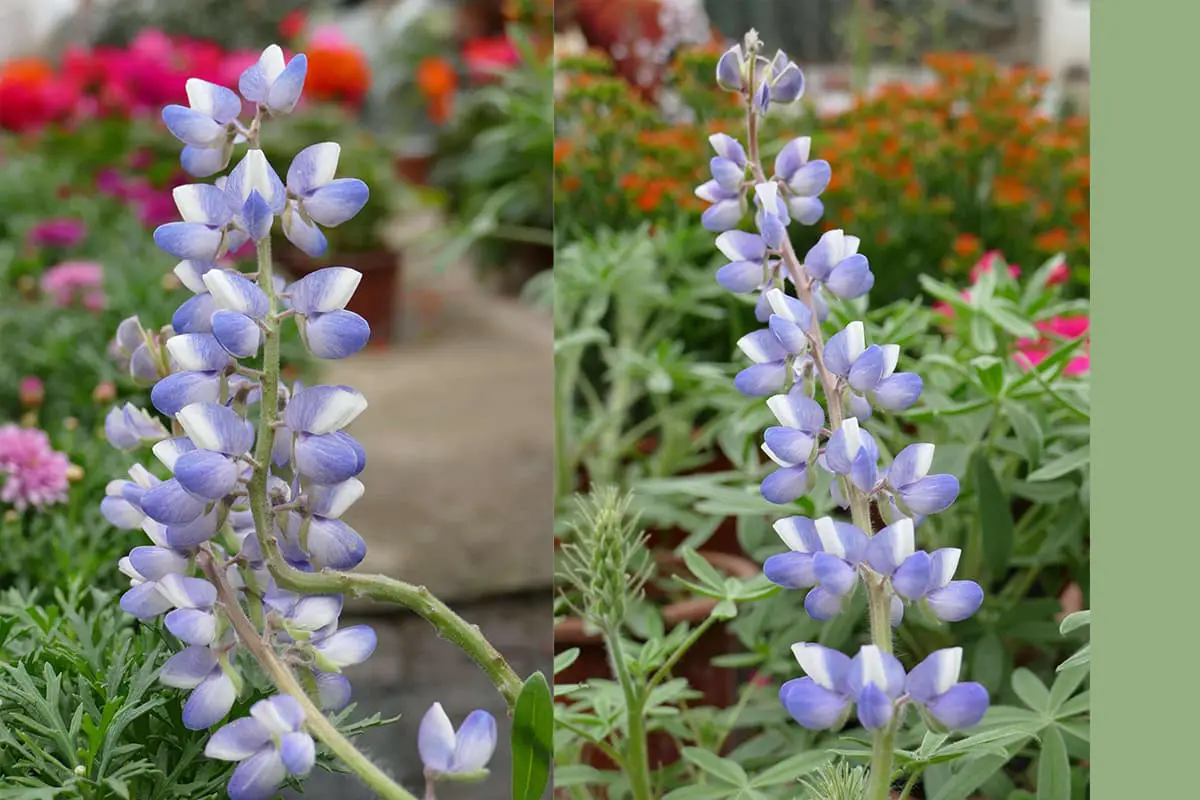
Lupinus micranthus, commonly known as small-flowered lupine or chick lupine, is an annual herbaceous plant that typically grows to a height of 10-50 centimeters (4-20 inches). The stem branches from the base and bears palmately compound leaves, each consisting of 5-9 leaflets. These leaflets are narrowly oblong to oblanceolate in shape, measuring 1-3 cm long and 2-5 mm wide. The leaves have a slightly fleshy texture and are often covered with fine hairs.
The inflorescence is a terminal raceme, usually 5-15 cm long, with a slender axis. Flowers are arranged alternately along the raceme and have very short pedicels, typically less than 2 mm long. The calyx is bilabiate (two-lipped) and densely covered with short, stiff hairs. The corolla is predominantly blue or purple, with the standard petal (banner) and keel petals often marked with white. Each flower is small, measuring about 6-8 mm in length.
The fruit is a legume pod, elongated and linear in shape, measuring 2-3 cm long and 4-5 mm wide. Each pod contains 4-6 seeds. The seeds are ovate, flattened, and smooth, with a mottled appearance combining shades of brown, black, and sometimes white. The plant typically blooms from March to May, with fruit development occurring from April to July.
Lupinus micranthus is native to the Mediterranean region, including parts of Southern Europe, North Africa, and Western Asia. It thrives in temperate climates and prefers well-drained, sandy soils with full sun exposure. The species is often found in coastal areas, grasslands, and disturbed habitats.
While Lupinus micranthus itself is not commonly cultivated, many other Lupinus species and hybrids are popular in horticulture. These ornamental lupines, often referred to simply as “lupines” or “bluebonnets,” feature upright, densely packed inflorescences with a wide range of flower colors including white, pink, red, blue, purple, and bicolor varieties.
Ornamental lupines are prized for their long flowering period, typically lasting from late spring to mid-summer. They are ideal for creating colorful displays in borders, cottage gardens, and wildflower meadows. When planted in groups or drifts, they create stunning visual impact. Additionally, lupines make excellent cut flowers, lasting up to a week in floral arrangements.
It’s worth noting that while ornamental lupines are beautiful and popular in gardens, they should be handled with care as all parts of the plant contain alkaloids that can be toxic if ingested in large quantities. Moreover, some people may experience skin irritation when handling lupines, so wearing gloves is advisable during cultivation and maintenance.

Lupinus Polyphyllus, commonly known as Large-leaved Lupine or Big-leaved Lupine, is a striking perennial herbaceous plant belonging to the Fabaceae (legume) family and the Lupinus genus. This species features an upright stem that branches out in tufts, creating a robust and bushy appearance. The plant’s surface is either glabrous or sparsely covered with soft hairs, particularly on the upper portions.
The leaves of Lupinus Polyphyllus are compound and palmate, with petioles significantly longer than the individual leaflets. Each leaf typically consists of 9-17 leaflets arranged in a circular pattern. The leaflets exhibit an elliptical to oblanceolate shape, with tips varying from obtuse to acute. The adaxial (upper) surface of the leaflets is usually glabrous, while the abaxial (lower) surface is moderately covered with appressed hairs, giving it a slightly silvery appearance.
The inflorescence is a tall, erect raceme that extends well above the foliage, often reaching 60-150 cm in height. The flowers are densely packed and alternate along the raceme, creating a striking vertical display. Individual flowers are typically 1-1.5 cm long and exhibit the characteristic pea-like structure of legumes. The flower colors can range from deep blue to purple, pink, or white, depending on the variety. The bracts subtending each flower are ovate-lanceolate, pubescent, and caducous (falling off early).
Following pollination, elongated pods develop, densely covered with silky hairs. These pods, when mature, contain ovate seeds that are gray-brown with deep brown mottling and a smooth surface. The flowering period extends from June to August, with fruit development and seed maturation occurring from July through October.
Native to the western United States, particularly the Pacific Northwest, Lupinus Polyphyllus has adapted to cool, temperate climates. It thrives in full sun to partial shade and requires consistent moisture, making it well-suited to areas near streams or in meadows. This species is not heat-tolerant and may struggle in hot, humid environments.
While Lupinus Polyphyllus is not particularly fussy about soil type, it performs best in loose, well-draining, fertile loam with a slightly acidic to neutral pH (6.0-7.0). Like many legumes, it has the ability to fix nitrogen, which can improve soil fertility over time.
Propagation of Lupinus Polyphyllus is typically done by seed. For best results, seeds should be scarified (lightly scratched or soaked in warm water) before planting to improve germination rates. Direct sowing in autumn or early spring is often successful, as the seeds benefit from a period of cold stratification.
The impressive inflorescences of Lupinus Polyphyllus make it a valuable ornamental plant in gardens and landscapes. It can be used effectively in borders, cottage gardens, or naturalized areas. The long stems with densely packed flowers are excellent for cut flower arrangements, providing a dramatic vertical element. When placed in vases or water containers, they can last for several days with proper care.
One of the key advantages of Lupinus Polyphyllus is its extended flowering period, which can last up to two months under ideal conditions. Deadheading spent flower spikes can encourage additional blooming and prolong the display.
It’s worth noting that all parts of Lupinus Polyphyllus contain alkaloids and are toxic if ingested in large quantities. Therefore, care should be taken when planting in areas accessible to livestock or pets. Additionally, while the plant is generally low-maintenance, it can be susceptible to aphids and fungal diseases in humid conditions, so good air circulation and proper spacing are important for healthy growth.
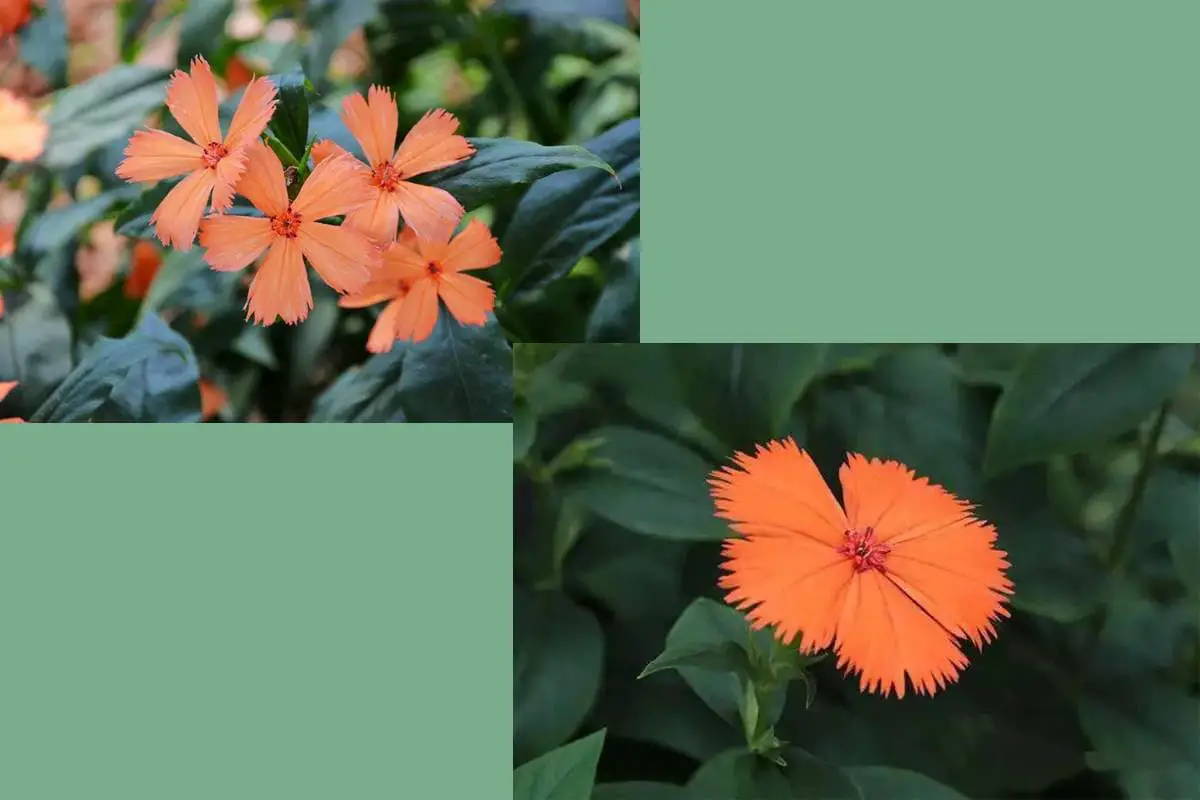
Lychnis coronata, commonly known as Chinese Campion or Rose Campion, is a striking perennial herb belonging to the Caryophyllaceae family. While traditionally classified under the Lychnis genus, it is now more accurately placed in the Silene genus, with its botanical name updated to Silene coronata.
This nearly glabrous plant typically reaches a height of 50-90 cm. Its root system consists of clustered, slender cylindrical roots that are yellow-white in color and slightly fleshy in texture, providing efficient nutrient absorption and anchoring.
The stems of Lychnis coronata are usually solitary, though occasionally they may form sparse clusters. These erect stems support leaves that exhibit variability in shape, ranging from elliptical to obovate-lanceolate or ovate to obovate-lanceolate. This leaf morphology allows for efficient light capture and photosynthesis.
The inflorescence is a dichasial cyme, often bearing several flowers. Each flower is a striking 4-5 cm in diameter, featuring very short pedicels sparsely covered with fine pubescence. The large, showy flowers are a key characteristic of this species, making it highly valued in ornamental horticulture.
The fruit is a capsule, elongated-ovoid in shape and approximately 20 mm long. It’s worth noting that while seed production occurs, detailed observations of the seeds are limited in current literature, suggesting an area for further botanical research.
Lychnis coronata follows a specific phenological pattern, with flowering occurring from June to July and fruiting from August to September. This timing aligns with the warm summer months, optimizing pollination and seed development.
Native to China, Lychnis coronata has also been cultivated extensively in Japan, demonstrating its adaptability to various East Asian climates. In its natural habitat, it thrives in the dappled shade of sparse forests or among the diverse plant communities of shrub grasslands.
As one of China’s traditional ornamental plants, Lychnis coronata holds cultural significance beyond its botanical interest. Its vibrant, multicolored blooms emerge in early summer and continue to provide visual interest well into autumn, making it a valuable addition to gardens with extended seasonal appeal.
In landscape design, Lychnis coronata proves versatile. It excels in mixed borders, cottage gardens, and naturalistic plantings. Its upright form and bright flowers make it an excellent choice for adding vertical interest and color to flowerbeds. Moreover, its adaptability to container cultivation expands its use in urban and small-space gardening. The long-lasting blooms also lend themselves well to cut flower arrangements, bringing the beauty of this Chinese native indoors.
For optimal growth, Lychnis coronata prefers well-drained, fertile soil and partial shade to full sun exposure. Regular deadheading can prolong the blooming period, while division every few years helps maintain plant vigor. With proper care, this plant not only enhances garden aesthetics but also supports pollinators, contributing to local biodiversity.

Lycoris Aurea, commonly known as Golden Spider Lily, is a striking perennial herbaceous plant belonging to the Amaryllidaceae family and Lycoris genus. This species is characterized by its ovate bulbs and distinctive sword-shaped leaves that narrow at the base and taper at the tip, featuring a prominent pale band along the midrib.
The plant produces an umbellate inflorescence with eye-catching golden-yellow flowers, typically blooming from August to September. Each flower displays inversely lanceolate tepals with a pale green midrib on the reverse side. The filaments are yellow, contrasting beautifully with the rose-red upper part of the column, creating a visually appealing display.
Following the flowering period, Lycoris Aurea develops three-edged capsules that dehisce dorsally, containing nearly spherical, black seeds. The fruiting stage usually occurs in October.
Native to China, Lycoris Aurea has naturalized in Japan, Myanmar, and other Asian countries. It thrives in its natural habitat on damp, shaded hillsides, preferring semi-shaded locations with consistent moisture. This adaptable plant demonstrates cold tolerance and drought resistance, flourishing in well-draining sandy loam soil enriched with organic matter.
Cultivation of Lycoris Aurea is relatively straightforward, with propagation typically achieved through bulb division. This method ensures the preservation of desirable traits and allows for the expansion of plantings.
Beyond its ornamental value, Lycoris Aurea holds significant importance in traditional Chinese medicine. The bulbs, characterized by their spicy and sweet flavor, are considered “cold” in nature according to traditional Chinese medical theory.
While toxic and requiring careful use under professional guidance, they are believed to possess properties that moisturize the lungs, alleviate coughs, detoxify the body, and reduce swelling. Traditional applications include treating lung heat-induced coughs, hemoptysis, yin deficiency fever, urinary difficulties, and various skin conditions such as abscesses and sores.
In landscape design, Lycoris Aurea’s adaptability and vibrant blooms make it a versatile choice for various settings. It can be effectively incorporated into flower beds, mixed borders, or naturalized in lawns. Its ability to thrive in partially shaded areas makes it an excellent option for planting as ground cover beneath sparse forests or in woodland gardens.
Additionally, the long-lasting flowers of Lycoris Aurea are prized in floral arrangements, adding a touch of exotic elegance to cut flower displays.
The unique flowering pattern of Lycoris Aurea, where blooms appear before the foliage, adds to its allure in garden design. This characteristic, combined with its low maintenance requirements and resistance to pests and diseases, makes it an increasingly popular choice among gardeners and landscape architects seeking to create visually interesting and ecologically sound plantings.

Lycoris radiata, commonly known as the Red Spider Lily or Hurricane Lily, is a striking perennial bulbous plant belonging to the Amaryllidaceae family. This species is renowned for its unique flowering habit and vibrant red blooms that appear seemingly out of nowhere in late summer or early autumn.
The plant grows from an ovoid bulb, 2-3 inches (5-7.5 cm) in diameter, covered with purple-brown tunic. The leaves, which emerge after flowering, are linear to strap-shaped, about 12-18 inches (30-45 cm) long and 0.3-0.5 inches (8-12 mm) wide, with a distinctive pale green central stripe.
The flower scape, rising to 12-24 inches (30-60 cm) tall, emerges before the leaves, typically in late summer. Each scape bears an umbel of 4-6 spider-like flowers. The flowers are brilliant red, occasionally white in rare variants, with a funnel-shaped perianth that splits into six narrow, recurved segments, each about 2-3 inches (5-7.5 cm) long. The base of the perianth forms a short tube with small scales at the throat.
A distinctive feature of Lycoris radiata is its long, protruding stamens and style, which extend well beyond the perianth, giving the flower its spider-like appearance. The pistil is slender and longer than the stamens, terminating in a minute stigma. Flowering typically occurs from August to September, creating a stunning display.
Native to China, Korea, and Japan, Lycoris radiata has naturalized in many parts of the world, including the southern United States. It prefers partial shade but can tolerate full sun in cooler climates. The plant is adaptable to various soil types but thrives best in moist, well-drained, fertile sandy loam. While it can endure brief periods of drought once established, consistent moisture during the growing season promotes optimal growth and flowering.
Propagation is primarily through bulb division, best done immediately after flowering or in early spring before new growth begins. Seeds are rarely produced in cultivation, and when they do occur, they have low viability.
In the landscape, Lycoris radiata makes an excellent addition to woodland gardens, border edges, or naturalized areas. Its sudden emergence and vibrant blooms create focal points in the late summer garden. The flowers are also suitable for cutting, lasting several days in floral arrangements.
It’s important to note that all parts of Lycoris radiata contain toxic alkaloids, including lycorine. While this makes the plant resistant to deer and rodents, it also means it should be handled with care, especially in gardens frequented by children or pets. In traditional medicine, the bulbs have been used for their emetic properties, but such use is not recommended without professional guidance due to their toxicity.
The plant’s sudden appearance and brilliant flowers have inspired various cultural associations. In Japan, it’s known as Higanbana and is often associated with death and the afterlife, frequently planted in cemeteries. In China, it’s called Shiduoluo (石蒜), meaning “rock garlic,” referring to its bulb’s resemblance to garlic and its tendency to grow in rocky areas near streams.
The nickname “magic flower” aptly describes its seemingly magical emergence, while “thunderclap on flat ground” poetically captures the dramatic impact of its sudden, mass flowering. These evocative names highlight the Lycoris radiata’s ability to create spectacular, unexpected displays in the late summer landscape, making it a prized addition to gardens worldwide.
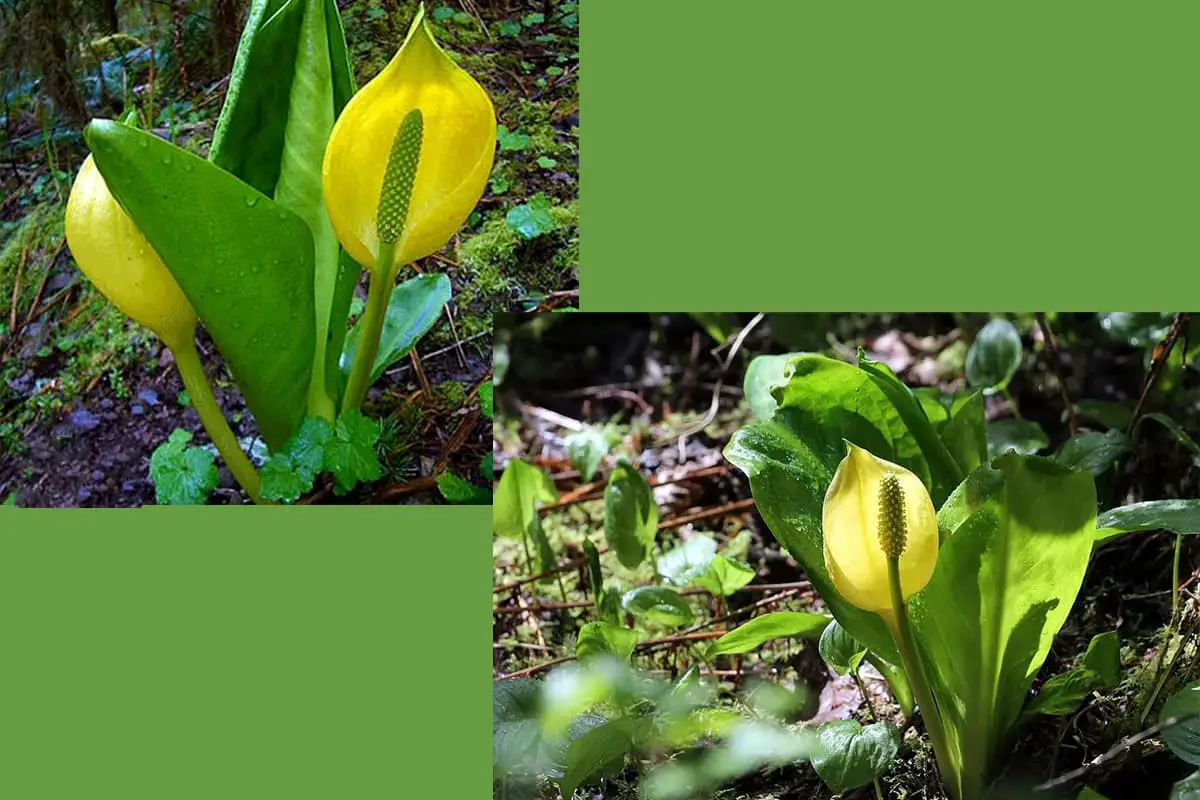
Lysichiton americanus Hultén, commonly known as Western Skunk Cabbage or Yellow Skunk Cabbage, is a striking perennial herb native to the wet, temperate regions of western North America. This robust plant thrives in swamps, marshes, and damp forest floors, particularly in the Pacific Northwest of the United States.
A member of the Araceae family, L. americanus is characterized by its large, bright yellow spathe surrounding a spadix of tiny flowers. The leaves are massive, often growing up to 1.5 meters (5 feet) long and 70 cm (28 inches) wide, forming an impressive rosette. These leaves emerge after the flowers in spring and persist throughout the growing season.
The plant’s most distinctive feature is the pungent, skunk-like odor it emits, which can be detected from a considerable distance. This strong scent persists even in dried specimens, making it a memorable component of herbarium collections. The odor serves a crucial ecological function by attracting its primary pollinators, including flies, beetles, and early-season bees.
L. americanus has a wide distribution range, extending from Kodiak Island and Cook Inlet in southern Alaska, through British Columbia in Canada, and south along the Pacific coast to northern California, reaching its southernmost limit near Santa Cruz. It typically grows at elevations from sea level to about 1,400 meters (4,600 feet).
In its native habitat, Western Skunk Cabbage plays a vital role in the ecosystem. Its early spring emergence provides an important food source for bears emerging from hibernation. The large leaves also offer shelter to various small animals and amphibians.
While the plant contains calcium oxalate crystals that can cause irritation if ingested raw, some Indigenous peoples have traditionally used the leaves as food after careful preparation. The plant has also been employed in traditional medicine for various purposes.
As a garden plant, L. americanus can be an impressive addition to bog gardens or water features, though its strong odor and large size make it best suited for spacious, naturalistic settings. It requires consistently moist to wet soil and partial to full shade to thrive, mimicking its native habitat conditions.